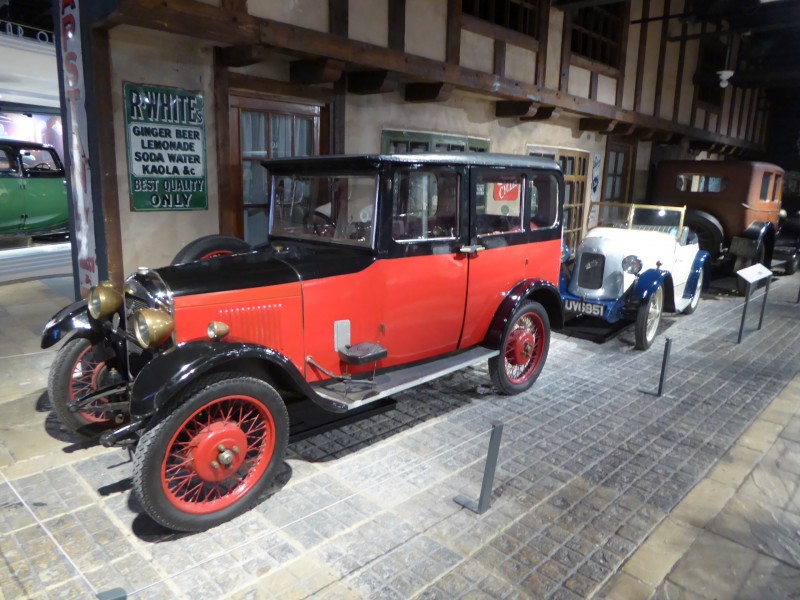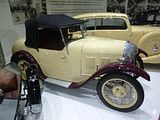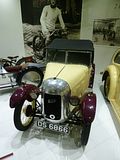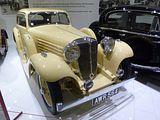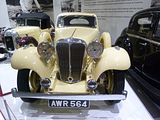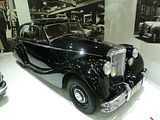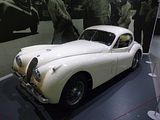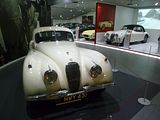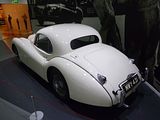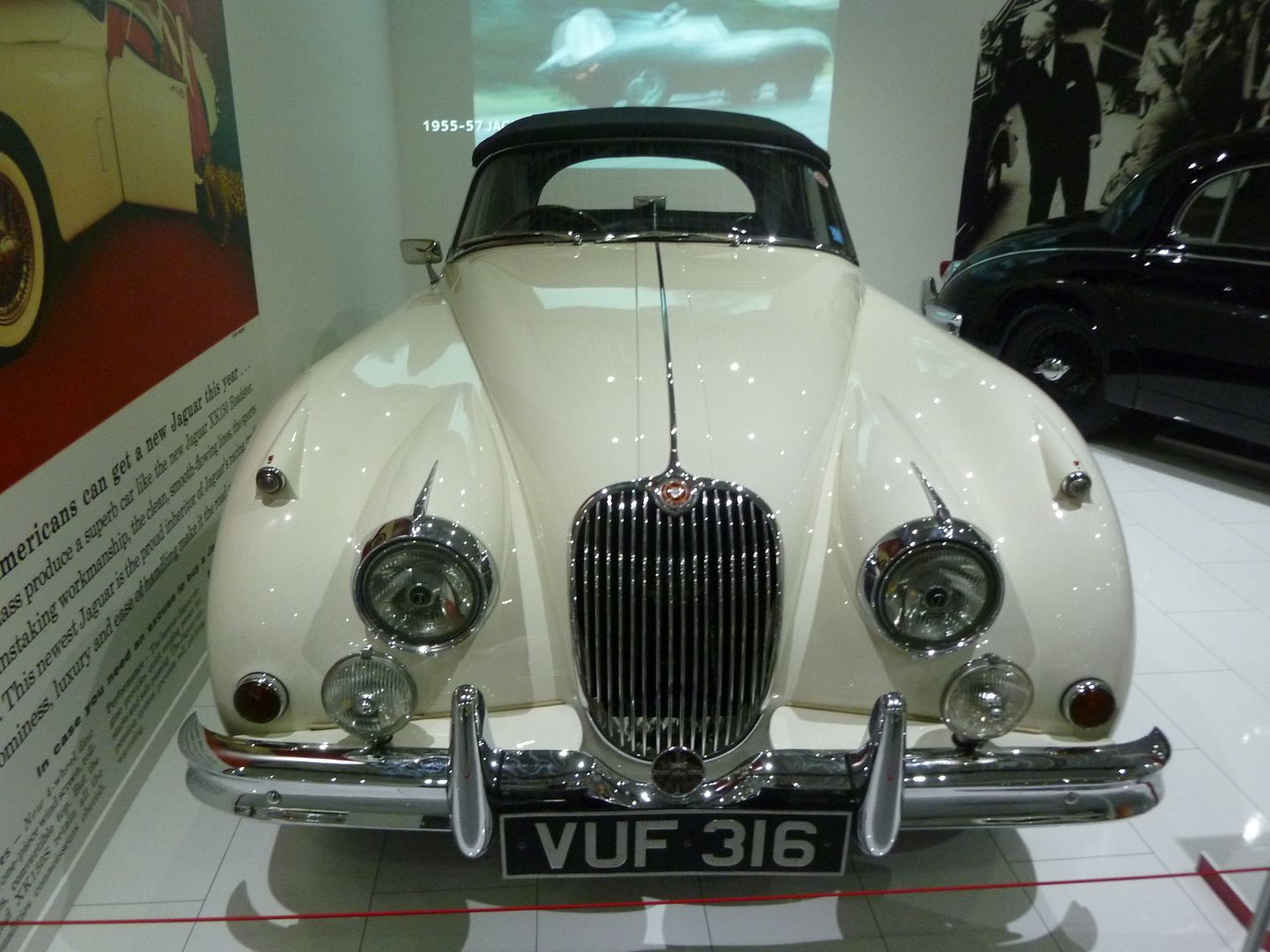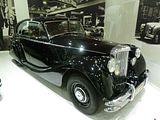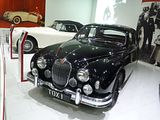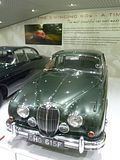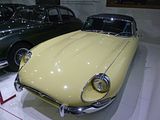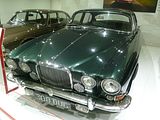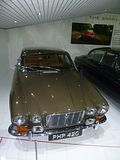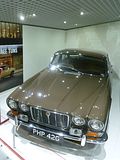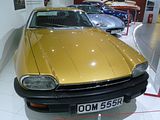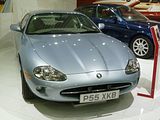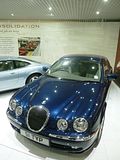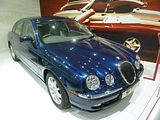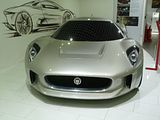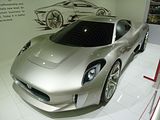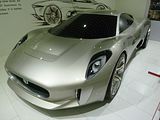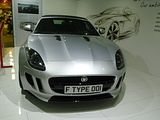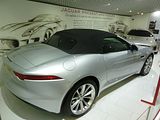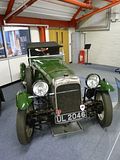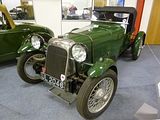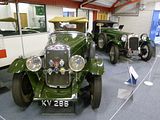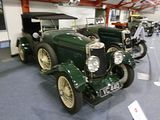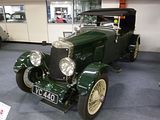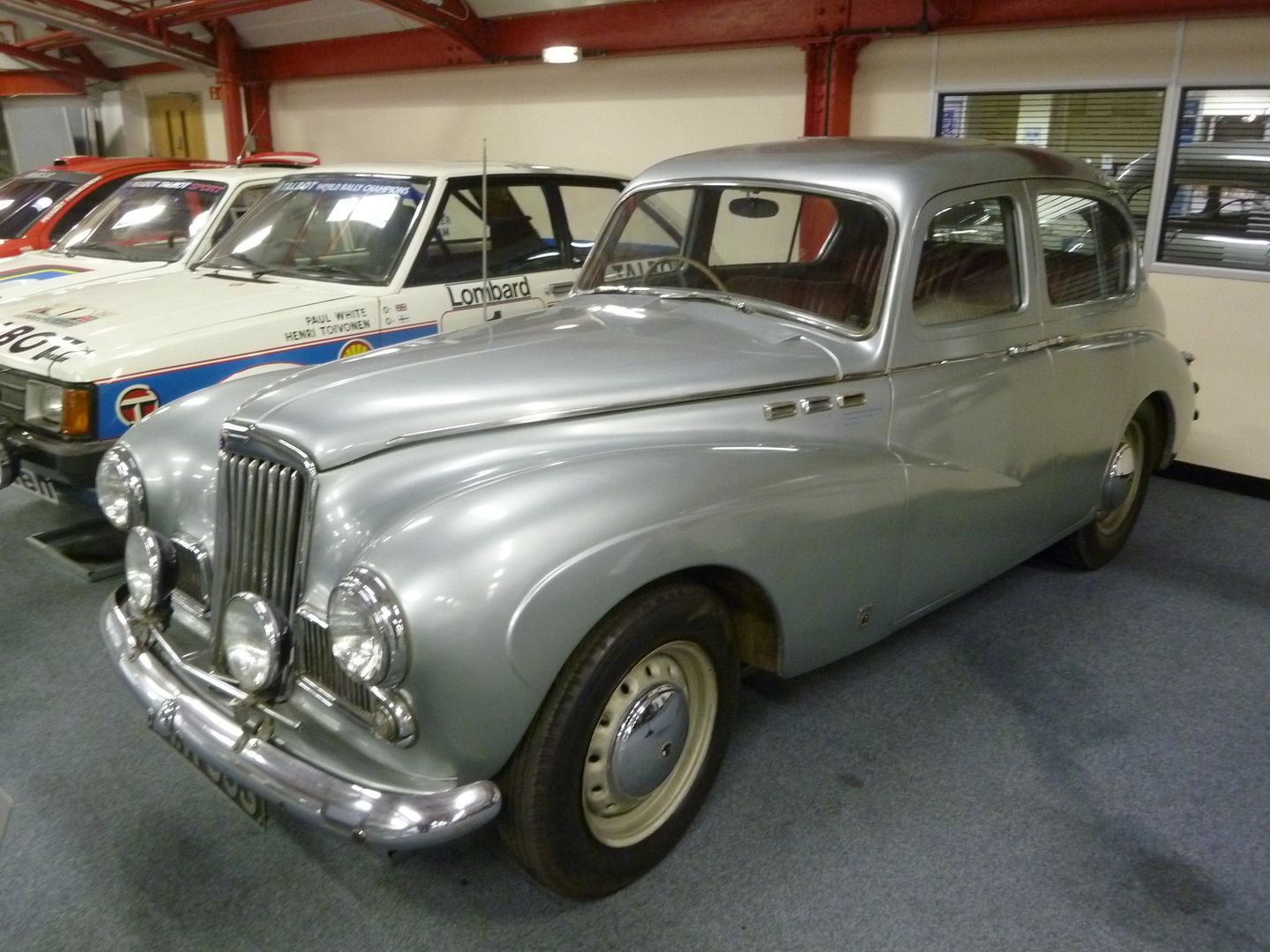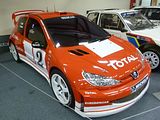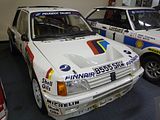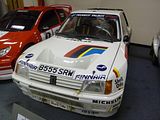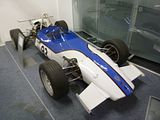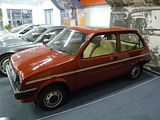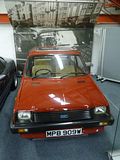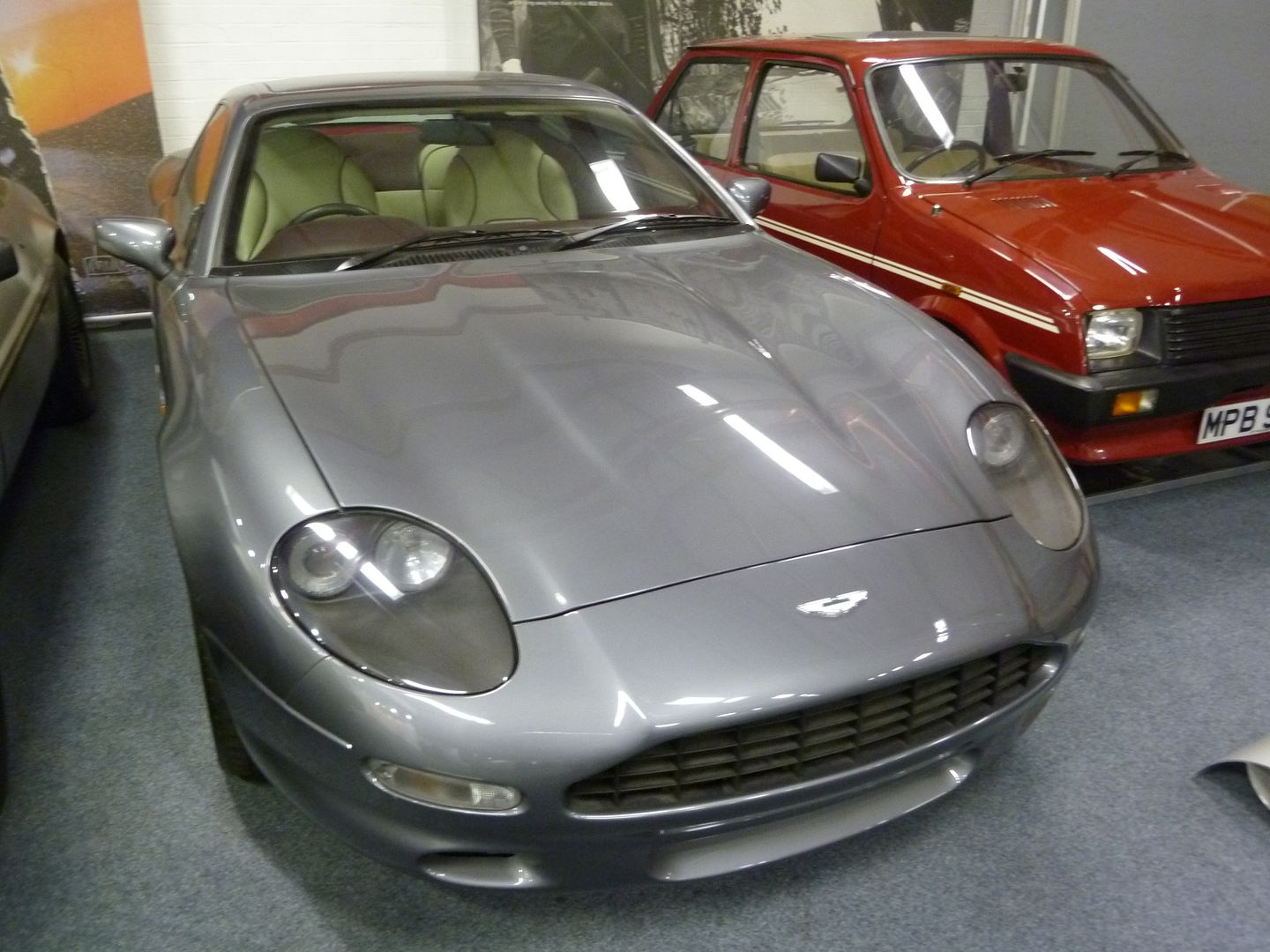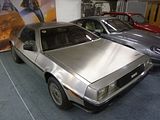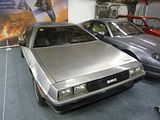There has been a transport museum in the centre of Coventry, celebrating the vast and diverse array of wheeled products which have been made in the city and environs, for a long time. I’ve visited a number of times and indeed have already published a couple of reports, depicting what was on show at the time of each visit. Although the building, in Millennium Square is sizeable, it is nothing like large enough to show the entire collection, even if the curator decided to put all the goodies out at once, so every visit tends to comprise a mix of things that were on show before and things that were not. When I went towards the end of 2013, a significant revamp of the entire museum was underway, with some of the cars protected by a large plastic bags, thus keeping the museum open whilst these works were underway. But to complete some of the more fundamental changes that had been devised, it proved necessary to close entirely for a number of months. The re-imagined museum opened to the public in June 2015, with around £9.5m having been spent to refresh the entire downstairs part of the facility, with a new route around the interconnected halls and fresh displays designed to tell the story that started with bicycles and which saw the city become the centre of UK car production before seeing almost all of disappear as the twentieth century drew to a close. I paid my first to see the changes for myself towards the end of 2015 and have been back several times since then, and this report updates those I’ve already produced, and which are still available on the site.
After you have passed through the main entrance, there is a cafe to your left, which serves a range of savoury snacks, cakes and pastries as well as teas and coffees, and to the right is the well-stocked shop, which you pass through on your way out – probably some hours after walking in. Head straight on, though, and before you is a single car on a display plinth. That car on all of these visits was this 1974 Jaguar E Type, one of the last V12 E-Types. It had just 300 miles on the clock when delivered to the museum. The E-Type is thought by many to be the ultimate in sports car body design. It was also the last E-type to be displayed at the Motor Show at Earls Court in 1974. At the show the car won the Society of Motor Manufacturers and Traders (SMMT) ‘Best Coachwork in Show’ and the car came from the Motor Show to the Museum.
BEFORE THERE WERE CARS
In the 1850s and 60s, the biggest industries in Coventry were silk production and watch making. With increasing industrialisation, new industries started to emerge and one of these was around the production sewing machines. Another was the production of the bicycle and soon Coventry became the first place in the country to build these new means of getting about. By 1895 there were over 30 cycle makers in the city. The museum has an amazing collection of over 300 cycles and you could spend a long time just pouring over these, fascinated by how you would even ride some of them!
This style of cycle is an “Ariel” design penny-farthing made by James Starley during the 1870s. The frame and wheels of this cycle are made from steel; this makes it a very heavy machine weighing in at about 50lbs. It has tangent spokes adjustable at the hub and solid rubber tyres. The brake is operated by twisting the handle-bars; this pulls a cable taught, which operates a roller onto the rear wheel and aids slowing-down. This design of bicycle has been referred to by several names over the years such as: penny-farthing, high-wheeler, and ordinary-bicycle. The idea of the penny-farthing’s large front wheel was to cover a longer distance with each revolution of the pedal. The pedals are directly connected to the driving wheel, making it quite difficult to control the steering.
Kirkpatrick McMullen was the first to produce a cycle,in 1868 which could be ridden without your feet on the ground.
This is the Velocipede, or Bone Shaker, made between 1865 and 1870.
It was around this time when there was a transition from the Penny Farthing style to something rather smaller, and easier to ride. In 1876, we saw Lawson’s Lever Safety Bicycle.
Trying to make the bicycle safer remained a theme, as exemplified by this Singer Extraordinary.
And so by 1886 we have the Swift Safety Bicycle and the 1888 Rover Safety Bicycle. The Rover Safety Cycle was created in Coventry by John Kemp Starley in 1888. When it was first built it was very different to any other cycle that had been built before, yet it looks like the cycles we ride today. It is quite similar in the construction of the frame and also has a chain which drives the rear wheel. From this point onwards, all cycle makers made cycles based on this design because it became so popular with riders.
THE DAWN OF MOTORING
It was no real surprise that as the first motor cars started to be produced in a number of countries across Europe, that it would be several of those companies who had been making bicycles would be the ones who looked to diversify into motorised transport. In 1896 Henry Lawson launched an initiative called the Motor Mills, trying to get all the city’s manufacturers together and wanting them to pay a patent fee. This included Daimler, Humber and MMC.
Oldest self-propelled vehicle on show was this 1896 Coventry Motette. This was built by Humber, based on a design by the French company Leon Bollee.
This 1898 Daimler Phaeton is one of the oldest cars to have been built in Coventry, a year after the Daimler Company was founded. It was made at a factory in the Drapers Field area of Coventry and would have cost £373. The body is made of wood and the style is a ‘Phaeton’. Phaeton was a God in Greek mythology, who drove the ‘chariot of the sun’ too fast. So Zeus, the king of Greek Gods, struck him with a lightning bolt to stop him setting the world on fire. Phaeton style carriages are seen as sporty and meant to be driven fast.
This car is believed to be the oldest surviving Standard and for this reason, has been given the number plate SMC1 (Standard Motor Company 1). It was originally exported to Australia in 1907 and was rediscovered in a barn on a tobacco farm in the 1950s. It was restored by Standard (Australia) apprentices and exported back to Britain in 1959, when it was presented by the Standard Motor Company to the City of Coventry.
There were a couple of cars from the Swift Motor Company: a 1913 Swift Cycle Car and a 1910 Swift Tourer. The Swift Motor Company made Swift Cars in Coventry from 1900 until 1931. It grew progressively from James Starley’s Coventry Sewing Machine Company, via bicycle and motorised cycle manufacture. The cars ranged from a single-cylinder car in 1900 using an MMC engine, through a Swift-engined twin-cylinder 7-horsepower light car in 1904, and a 3-litre model in 1913. After the First World War a successful range was sold during the 1920s, but the Cadet of 1930 was its last vehicle as it could not compete economically with volume manufacturers such as Ford and Morris Motors.
In 1907, William Hillman founded the Hillman Coatalen Motor Company with Louis Cotalan, a designer who like Hillman had originally worked for Humber cars. Early Hillmans had either 9.0 litre, 6-cylinder engines or 6.0 litre 4-cylinder units. In 1910 the company name was changed to Hillman Motor Company when Louis Coatalen left to join Sunbeam. This 1908 Hillman Coatalen cost £295, which was three times the average factory worker’s wage.
By 1905, 1369 cycles a day were being made in the city, This small display encompasses a 1900 Rudge Tandem, a 1911 motor cycle and a rather special 5-seater from 1900.
This is a 1911 Daimler 12HP, and a very rare example with a Knight sleeve valve engine. This engine was developed by the American engineer Charles Knight, and the Daimler Company adopted it in 1910. It was quieter than other engines of the period because it replaced the noisy poppet valves with a sleeve valve fitted between the piston and the cylinder wall. The car had a top speed of 40 mph and would have cost £375 when new, whereas a 57hp Daimler would have cost £900 for the chassis only, with the bodywork being extra. It was overhauled and returned to its original specifications by Daimler apprentices in 1944.
Significantly more expensive, listing at £685 when new was this 1912 Siddeley-Deasy Althorpe Special Cabrio. The Deasy Motor Car Manufacturing Company Limited was founded by Henry Hugh Peter Deasy in the factory that had previously been used to manufacture Iden cars. Deasy left in 1908 following disagreements with his Chief Engineer. In 1910 J D Siddeley took up the appointment of managing director having moved to Deasy in 1909 from managing Wolseley. The shareholders were so pleased with his success that on 7 November 1912 they unanimously agreed to change the company’s name to The Siddeley-Deasy Motor Car Company Limited. Siddeley’s name had been added to the product’s radiator in 1912. The company would merge with the Armstrong Whitley Motor Company after the first world war. to create the better known Armstrong Siddeley.
Much more affordable was this 1906 Rover 6HP Tourer, which retailed for £120. It was shown with 3 Rover bicycles, What would eventually become the Rover company began by manufacturing one of the landmark designs in the history of human transportation – John Kemp Starley’s ‘Safety Bicycle’. The firm’s first venture into powered transportation, an electrically powered tricycle, came in 1888 but it would be another 16 years, by which time its founder had died, before the Rover Cycle Company began experimenting with the internal combustion engine. Designer Edmund Lewis was recruited from Daimler and drew up Rover’s first series-production automobile, an 8hp single-cylinder car with aluminium backbone frame, an adventurous design that despite its shortcomings remained in production until 1912. Lewis followed up with a more conventional 6hp single-cylinder model, which earned itself the distinction of being Rover’s first entered in any competition, in this case the Bexhill Speed Trials of 1902. That is the model type seen here.
George Singer began his bicycle-making business in Coventry in 1874. At the time, he was foreman of the Coventry Sewing Machine Company, from which he resigned. He was joined in the business by J. E. Stringer, his brother-in-law. It appears Singer was inspired to produce a bicycle safer than the Ordinary (penny-farthing) type standard at the time, by cyclist George Dominy. Singer did not alter the large front and small rear wheel design of the Ordinary, but by raking the front forks (a first) did make it safer. He patented the design on 24 October 1878. For the rest of the 19th century, the company continued to produce bicycles. Singer Cycle began motor vehicle production in 1901, purchasing the manufacturing rights to the Perks & Hooch Motor Wheel, a one-cylinder engine contained in a spoked aluminium wheel, known as a motorwheel. It was a 222 cc four-stroke designed by former Beeston employees Edwin Perks and Frank Birch. A unique feature was that the engine, fuel tank, carburettor and low-tension magneto were all housed in a two-sided cast alloy spoked wheel. It was probably the first motor bicycle to be provided with magneto ignition. It was perhaps the only motorcycle engine of its era with reliable ignition. These were fitted to bicycles. The design was used by Singer & Co in the rear wheel and then the front wheel of a trike. This is a 1903 Singer Motorwheel.
The Maudslay Motor Company was founded by Cyril Charles Maudslay, great grandson of the eminent engineer Henry Maudslay to make marine internal combustion engines. He was joined by his cousin Reginald Walter Maudslay who soon left to found the Standard Motor Company. The engines did not sell very well, and in 1902 they made their first engine intended for a car which was fitted to chain-drive chassis. The three-cylinder engine, designed by Alexander Craig was an advanced unit with a single overhead camshaft and pressure lubrication. In 1902, Maudslay Motors made a petrol railway locomotive for City of London Corporation to draw trucks from the London, Brighton and South Coast Railway to the Corporation meat market at Deptford, this requiring 50 tons to be drawn up a gradient of 1 in 36. It was fitted with a three-cylinder engine developing 85 bhp at 450rpm, with cylinders of 9inch bore and stroke. Transmission was via a 2-speed change gear. The locomotive weighed 12 tons, and was provided with an 8 hp auxiliary engine which was used to start the main engine. This was the first commercially successful petrol locomotive in the world. The three-cylinder engine was followed in 1903 by a six-cylinder version, possibly the first overhead-camshaft six to go into production. For 1904 a range of cars was on offer, including one with a 9.6-litre version of the six-cylinder engine. The cars were among the most expensive on the British market. This is a 1909 Maudslay Landaulette.
Humber is another of those companies which started out producing bicycles. In 1896 the company built a prototype and nine production motorcars in their new Coventry premises. In November 1896 a car was exhibited at the Stanley Cycle Show in London. They are claimed to be the first series production cars made in England. At Humber & Company’s next general meeting in 1897 the managing director said they had received many letters asking if they would produce a motorised vehicle, and that they had in fact been working on this project for 2 years, but had delayed production until they found a suitably reliable engine. Having now found an engine they were gearing up for production. The first Humber car was produced in 1898 was a three-wheeled tricar. Their first conventional four-wheeled car appeared in 1901. Cars went into production in Beeston near Nottingham as well as Stoke, Coventry but to separate designs. Just as with bicycles Beeston Humber products retained their high quality image. Seen in this part of the display were a couple of early models: a 1910 Humber Tourer with a 4 cylinder 12HP engine, which cost £285; and a 1914 Humber Tourer with a 4 cylinder 11HP engine, and this one cost £350.
The Riley business began as the Bonnick Cycle Company of Coventry. In 1890 during the pedal cycle craze that swept Britain at the end of the 19th century William Riley Jr. who had interests in the textile industry purchased the business and in 1896 incorporated a company to own it named The Riley Cycle Company Limited. Later, cycle gear maker Sturmey Archer was added to the portfolio. Riley’s middle son, Percy, left school in the same year and soon began to dabble in automobiles. He built his first car at 16, in 1898, secretly, because his father did not approve. It featured the first mechanically operated inlet valve. By 1899, Percy Riley moved from producing motorcycles to his first prototype four-wheeled quadricycle. In 1900, Riley sold a single three-wheeled automobile. Meanwhile, the elder of the Riley brothers, Victor Riley, although supportive of his brother’s embryonic motor-car enterprise, devoted his energies to the core bicycle business. Riley’s founder William Riley remained resolutely opposed to diverting the resources of his bicycle business into motor cars, and in 1902 three of his sons, Victor, Percy and younger brother Allan Riley pooled resources, borrowed a necessary balancing amount from their mother and in 1903 established the separate Riley Engine Company, also in Coventry. A few years later the other two Riley brothers, Stanley and Cecil, having left school joined their elder brothers in the business. At first, the Riley Engine Company simply supplied engines for Riley motorcycles and also to Singer, a newly emerging motorcycle manufacturer in the area, but the Riley Engine Company soon began to focus on four-wheeled automobiles. Their Vee-Twin Tourer prototype, produced in 1905, can be considered the first proper Riley car. The Riley Engine Company expanded the next year. William Riley reversed his former opposition to his sons’ preference for motorised vehicles and Riley Cycle halted motorcycle production in 1907 to focus on automobiles. Bicycle production also ceased in 1911. Early Riley models seen here were a 1904 Riley Tri-Car as well as this 1908 Riley Tourer 12/18.
AN INDUSTRY GROWS
By 1913, the motor industry employed half of the male workers of Coventry. And although there was an inevitable pause during the years of the First World War, it was not long before the industry was growing again, and fast. Clearly that was only going to happen if mode people could afford a motor car, which meant that there was far more demand for cheaper cars. It proved hard for all those fledgling companies to compete, and so some of the early names disappeared, as the still fledgling industry started to see some consolidation.
Motorbikes ere still being produced in quantity, of course and these examples from Invicta, Rover and Hobart date from around 1920.
The 1920 Coventry Premier TriCar was from a company started by Louis Hillman and bought out by Singer in 1920.
This 1920 Alvis 10/30 Tourer is the oldest surviving Alvis. It is constructed from a steel frame with aluminium panels covering it. much like an airplane.
1921 Calcot Cabrio 10HP – 2500 were made and behind it is a 1921 Rover Tourer. which had a 12 HP, 6 cylinder engine and a 3 speed crash gearbox
The 1923 Humber Chummy was an 8 HP, 4 cylinder car which had a tiny extra rear seat. It cost £250.
The 1923 Standard Warwick had a 1944cc 4 cylinder engine which gave it a top speed 50 mph. 20,000 were made.
The 1923 Albatross got its name as a contraction of Albert Ross, its creator. It had a 10HP, 1247cc 4 cylinder. Just 12 were made and there are 2 survivors.
Another Swift, this is a 1923 Tourer. Costing £595, 1500 of these were made.
1921 Coventry Victor Motorcycle and Whitley side car
Richard Henry Lea and Graham Francis started the firm in Coventry in 1895, and began car production in 1903. They built motorcycles from 1911. In the 1920s they developed a reputation for good sports cars, fitting superchargers to 1500cc engines in lightweight cars. This is a 1925 Lea Francis J Type which had a 1496cc 12HP 4 cylinder engine and had front wheel brakes (!).
1922 Hazelwood Motorcycle and side car
1929 Standard Fullman fabric bodied car and chassis
The Rover 16/50 and Rover 16 are mid-sized cars which were produced by Rover from 1926 to 1929 and non-continuously from 1936 to 1947 respectively, Rover initially responding to requests for a more powerful engine for their four-cylinder 14 hp with the 16/50. It remained available into 1929 finishing its run soon after the demise of its smaller bore 14 hp twin. Meanwhile, Rover had begun to provide a six-cylinder 16 hp offering, their 2-litre, in its turn succeeded by their 16 hp Meteor. Announced 21 May 1926 to supplement their 14/45 the 16/50 engine had a larger bore and was now rated at 16 rather than 14 hp for tax purposes. Its cubic capacity was 2.4-litres instead of 2.1-litres. The whole chassis closely follows the design of the 14/45 as does the design of the new engine. A number of different bodies were available, with open tourers and saloon models offered. The saloon’s windscreen is V-shaped. The side windows have two sliding panels, two winding panels and fixed panels at the rear of the six-light body. The Weymann saloon’s front seat is slideable by hand. The spare wheel is carried at the back of the body in front of the folding luggage grid. This a 1927 Rover 16/50 with a fabric body, Weymann style.
This is the model of car that started the Jaguar Company. In 1922 William Lyons and William Walmsley started the Swallow Sidecar Company in Blackpool, UK, making motorcycle sidecars. In 1928 the firm moved to Coventry and began making cars based on the Austin Seven and later Standard cars. In 1934 William Lyons took sole control of the company, renaming it SS Cars Limited. After WW2 (1945) Lyons renamed the company Jaguar Cars. The rest is history as they say. This is a 1929 Austin Seven Swallow, which had a 780cc 4 cylinder and a top speed of a heady 35 mph.
By 1929, Singer was the third largest car maker in the UK with 8000 employees and were building 28,000 cars a year. Some of that growth came with the launch in 1926 of the Junior, a rival to the Austin Seven. It had an 848cc engine which generated 16.5 bhp, and initially only rear wheel brakes. Singer were hampered by a lack of space at their factory, initially, which limited the number of cars that they could build, but once that was addressed by the move to a new works, they continue to evolve their range from what had been a simple one comprising the Junior and the larger Senior with a bewildering mix of engines and body styles. The Junior was produced until 1932 when it was replaced by the Nine.
This is the first Hillman Minx, dating from 1931. Launched on 1st October that year, it was straightforward and conventional with a pressed-steel body on separate chassis and 30 bhp 1185 cc engine producing cushioned power. It was upgraded with a four-speed transmission in 1934 and a styling upgrade, most noticeably a slightly V-shaped grille. For 1935 the range was similar except that synchromesh was added to all forward gears and this Minx became the first mass-produced car with an all synchromesh gearbox. it was designed by Rootes’ technical director Captain John Samuel Irving (1880-1953) designer of Sunbeam aero engines and Sunbeam’s Golden Arrow in conjunction with Alfred Herbert Wilde, (1891-1930) recently chief engineer of Standard and designer of the Standard Nine. The Minx cost £159 at launch.
Sitting above it in the Hillman range was the Wizard, a six-cylinder car which was produced between April 1931 and 1933. The Wizard was produced in two models, the 65 and 75. Both engines had a 106 mm stroke, meaning the 65 model measured 2,110 cc and was rated at 15.7 HP whilst the 75 model measured 2,810 cc and generated 20.9 HP. The 75 model was predominately targeted towards export markets, given the additional £5 horse-power tax that was payable owing to its larger capacity The key selling point for the Wizard, the self-proclaimed “Car of the Moderns”, was that it had been tested for international conditions, not just those found in Great Britain. The car was reportedly subjected to every conceivable and practical test. Photos exist to this date of the Wizard being test-driven in France, Spain, Italy, Austria, Algeria, Egypt and Morocco. The Wizard was first released with five body styles, each available in a choice of three colours. The models were the five-seater family saloon, £270; saloon de luxe, £285; coupe-cabriolet, £299; four-door sports saloon, £299; five-seater tourer, £270. The bare chassis was available for £198. The cheaper family saloon and touring car models came with 19 inch steel artillery wheels. Wire wheels were available for an additional £7 10/-. All other models had wire wheels as standard, and Triplex Safety Glass throughout instead of only for the windscreen. The car seen here is a 1933 Hillman Wizard 75 Cabrio with a Tickford body.
The 1930 Humber Snipe, or, as it was called from late 1932, Snipe 80 featured a 3498-cc six-cylinder engine of 80 mm bore and 116 mm stroke with the overhead-inlet, side-exhaust valve gear that had been a feature of the company’s six-cylinder engines since the mid-1920s. A single Stromberg carburettor was fitted. The four speed transmission had a right hand change lever (right hand drive cars) until 1931 when it moved to the centre of the car facilitating the production of left hand drive examples. The shutters on the radiator grille were opened and closed thermostatically to control the flow of cooling air. For 1933 the engine was redesigned to have overhead valves producing an extra 5 bhp. Bendix mechanical brakes were fitted. The conservatively boxy 4 or 6 light saloon body with spare wheels mounted on the front wings incorporated rear-hinged doors for back passengers. A fabric saloon (until 1930), sports saloon, tourer and drophead coupé were also listed and bare chassis were also supplied to outside coachbuilders. In 1930 on the home market the chassis sold for £410, the tourer £495, coupé £565 and saloon £535. With a 120-inch wheelbase and a total length of 173 inches, the car was, by the standards of the British market, larger and more spacious than the average family car such as the more mainstream Hillman Minx of that time, the Hillman business having been acquired by Humber in 1928. With the success of the Snipe, Humber was seen to be succeeding, “where many had failed, in marketing large cars at competitive prices”. There were several minor body updates for 1933 including windscreen wipers mounted below rather than above the screen, recessed direction indicators and two tone paint on the 4-light sports saloon. 1205 of the 1933 models were made. In 1931 a fleet of Snipes was used by the Prince of Wales on his tour of the West Indies. The body and chassis were shared with the smaller engined 16-50 (1930–32) and 16-60 (1933) models. A new model was launched in 1935.
This is a 1932 Alvis 12/60 “Beetle Back”. The origins of the car start with the first 12/50 models, launched in 1923, and often referred to as the “Duck’s Back” because of their tail-end styling. Constant revisions saw a progression of new versions on at least an annual basis. The 12/50 was withdrawn between 1929 and 1930 when the company decided that the future lay with the front-wheel drive FD and FE models, but when these did not reach the hoped for volumes a final version of the 12/50 was announced for the 1931 model year as TJ. Fitted with the 1645 cc engine this continued in production until 1932. The ‘post-vintage’ TJ is referred to by Alvis historians as being from the ‘revival period’, and it differs from its predecessor in a number of ways, notably coil instead of magneto ignition, deep chromed radiator shell, and rear petrol tank in place of the scuttle-mounted tank on most older 12/50s. The TJ was joined in the range by a more sporting version of the same chassis, but this car was marketed not as a 12/50, but as the 12/60. The TK 12/60 was available in 1931, and the TL 12/60 in 1932.
This is a 1930 Standard Swallow, which had an 1141cc 9HP engine and cost £250. When Lyons and Walmsley decided to move into car production, the first model that they looked to as a base for their ideas was the Austin 7, a popular and inexpensive vehicle. For their show car Swallow’s Bolton, Lancashire agent had persuaded a dealer in Bolton to supply him under-the-counter (coachbuilders required Austin’s prior approval or warranties might be voided) with an Austin 7 chassis. Lyons, with a sketch of what he wanted, commissioned Cyril Holland, a coachbuilder by trade, to create a distinctive, open two seater body. Holland gave it a detachable hardtop with a characteristic back window. The result was announced to public in May 1927, the Austin Seven Swallow. Austin gave their approval to the Swallow coachwork though adjustments were needed, the wings kept falling onto the tyres and the cycle type was dispensed with in favour of the more usual shape. In that form it was taken to London and shown to Henlys — Bert (Herbert Gerald) Henly and Frank Hough — who ordered 500 both two-seaters and saloons. Priced at only £175, the Swallow, with its brightly coloured two-tone bodywork and a style that imitated the more expensive cars of the time, proved popular in the prosperous late twenties and in the following depression. Soon after, a saloon version was produced: the Austin Seven Swallow Saloon, and the model seen here is one of these.
This is a splendid 1934 Triumph Gloria. Launched in 1934, there was a large and complex range of Gloria sporting saloons, coupés, tourers, 2-seater sports cars, drophead coupés and golfer’s coupés. All these Glorias, apart from the final two models, the 1.5 litre Saloon and Fourteen (1767 cc) Six-Light Saloon of 1937-1938 were powered by 1087 or 1232 cc four-cylinder or 1467 or 1991 cc six-cylinder Coventry Climax overhead inlet and side exhaust valve designed engines modified and built under licence by Triumph. The chassis came in two lengths, with an extra 8 in ahead of the passenger compartment depending on whether the four- or six-cylinder engine was fitted, and had conventional non-independent suspension with semi elliptic leaf springs. The brakes were hydraulically operated using the Lockheed system with large 12 in drums. A four-speed transmission was fitted with an optional free wheel mechanism allowing “clutchless” gear changing. Synchromesh was fitted to the gearbox on the final Fourteen and 1.5-litre models. From August 1934 to 1936 the Gloria range included ‘Gloria Vitesse’ models (not to be confused with later Vitesses) which were up-rated, with twin carburettor engine and equipment, versions of the equivalent Gloria and slightly different bodywork in the case of some saloons. From 1934 to 1937, there was also an open two-seat sporting model, the Southern Cross, re-using the name previously applied to the sports version of the Triumph Super 9. This used a shortened chassis of 96 in for 1232 cc four-cylinder models and 104 in for the 1991 sixes. The car seen here is a 1935 Southern Cross with the 4 cylinder engine.
The Singer Nine was launched in 1932, to replace the Junior. It featured a larger 972 cc overhead cam engine, based on the 848 cc engine seen in the 8HP Junior. This variation had already been introduced in the Junior Special, a short-lived interim model shown at the 1931 Olympia Motor Show four months before the Nine’s introduction. Power output was 26.5 hp, and this was transmitted through a four-speed manual gearbox. As well as the conventional four door saloon models, Singer offered a four-seat tourer model with abbreviated bumpers and no running boards called the “Nine Sports” from October 1932, and one of these managed to finish thirteenth at the 1933 24 Hours of Le Mans race. In 1933, celebrating this moderate success, a new underslung racy two-seat model called the Singer Le Mans appeared. With twin SU carburettors, the Sports offered 31 hp at 4600 rpm, providing a 66 mph with the wind screen down – impressive for the era and at a price considerably lower than the competition. The Nine Sports was also used in various other endurance races, finishing second in class in the 6-day Coupe Internationale des Alpes trial in 1933. For 1934 the front bumpers were elongated to protect the paintwork on the sides of the car, as the earlier short units were found wanting. For 1935, as the sportier Le Mans gained a four-seater option, running boards appeared on the Nine Sports along with larger doors and a curvier rear end. In 1936, the shorter and simpler Nine-engined Bantam Nine appeared, and in 1937 the Nine was discontinued in favour of this model. However, in 1939 the “Nine” name reappeared on a new Roadster model which depended heavily on the Bantam, meaning that the Nine was to continue in production until into 1949, and as the 4A/4AB until 1953. This is a 1934 Singer Nine Coupe.
By the 1930s, Riley had a huge number of different models in their range, which would prove to be their undoing and why the company needed to be rescued by the Nuffield Group in 1938. Seen here is a 1935 Riley Kestrel, which is one of the range of 12/4 models launched to replace the earlier 12/6 cars. At launch three body styles were available: the Kestrel 4 light fastback saloon, the Falcon saloon and the Lynx open tourer. In 1936 the Kestrel became a six light, the Falcon was replaced by the Adelphi six light saloon and the Continental touring saloon was introduced. Production of all ceased in 1939.
The early 1930s were tough times for those making cars, as the effects of the Great Depression took hold, but under the guidance of the chairman, William Lyons, the SS Company survived by making a series of beautifully styled cars offering exceptional value for money although some enthusiasts criticised them at the time for being “more show than go”. The engines and chassis supplied by the Standard Motor Company were fitted with Swallow bodies styled under Lyons supervision. The first of these SS range of cars available to the public was the 1932 SS 1, which was available with either a 2-litre or 2½-litre side-valve, six-cylinder engine and it was followed by the SS 2 with a four-cylinder 1-litre side-valve engine. At £385 brand new they were one of the cheapest ‘quality’ sports saloons on sale at the time. Seen here is an SS1 Coupe from 1935.
This very imposing 1935 car is known as Queen Mary’s Daimler, 1 of 2 given to HM Queen Mary, the Queen’s Grandmother, and retained by herfrom 1935 until her death in 1953. It was acquired by the National Motor Museum in the mid-1950s, and was then placed on loan to the owners of the liner ‘Queen Mary’, which by then, was a floating hotel in Long beach, California. The car was exhibited for over ten years on the deck of this once great liner, yet during this time suffered from the sun, rain, and in particular, the damp salty air. Following a conversation in 1984 between Michael Ware, Curator of the National Motor Museum, and Barry Littlewood, then General Manager of this Museum, the vehicle was purchased for the Coventry collection and returned to the City of its making in July of that year. Since that time the vehicle has been totally restored to its former glory and now takes pride of place amongst the other Coventry made exhibits in the Museum.
This is another Daimler used by the Royal Family, and is thought to have been used by a lady-in-waiting to the Queen’s mother, Elizabeth Bowes-Lyon. It appeared in the coronation procession for King George VI in 1937. This 450cc straight-8 engined car has a pre-selector gearbox and has an alloy body built by Barker & Co, trimmed to the highest standard, including leather interior. Extra (folding) seats were fitted to enable nine passengers to be carried in the utmost comfort. With its Daimler fluid drive flywheel and pre-selector gearbox the car is almost silent when running, yet despite its sheer bulk it can still manage 70mph if required.
The Alvis 4.3-litre and Alvis Speed 25 were British luxury touring cars announced in August 1936 and made until 1940 by Alvis Car and Engineering Company in Coventry. They replaced the Alvis Speed 20 2.8-litre and 3½-litre. They were widely considered one of the finest cars produced in the 1930s. The Speed Twenty’s 2½-litre, 2.8-litre or 3½-litre engines with four main bearings were replaced in the 4.3-litre and 3½-litre Speed Twenty-Five with a strengthened new designed six-cylinder in-line unit now with seven main bearings. For the 3½-litre version an output of 110 PS at 3,800 rpm was claimed (and proven) along with a top speed of almost 100 mph. It propelled the occupants at high speed in exceptional luxury accompanied by the attractive sound of a powerful deep and throaty exhaust. Its beauty is also confirmed as it is the only car to win the prestigious Ladies Choice VSCC Oxford Concourse prize two years in a row. The clutch, flywheel and crankshaft were balanced together, which minimised vibration. The cylinder head was of cast iron but the pistons were of aluminium. Two electric petrol pumps fed the three SU carburettors, which were protected by a substantial air filter. A new induction system incorporated an efficient silencing device. Rear springs were 15 inches longer than in the previous model. The brakes had servo assistance. Alvis did not make any of the bodies for the Speed 25. The cars were supplied in chassis form and firms such as Cross & Ellis (standard tourer) Charlesworth (standard saloon and Drop Head Coupé) as well as Vanden Plas, Lancefield, Offord and others would fit suitably elegant open touring or saloon car bodies. The car was built on a heavy steel chassis with a substantial cross brace. With its sporty low slung aspect, all-synchro gearbox, independent front suspension and servo-assisted brakes, this was a fast, reliable and beautifully made car, although at almost £1000 it was not cheap. The survival rate for what was after all a hand-built car is surprisingly good. Later models featured increased chassis boxing, and to reduce the car’s weight Alvis cut numerous holes in the chassis box sections, which was also a solution tried less successfully earlier in the decade by Mercedes-Benz when confronting the same challenge with their enormously heavy Mercedes-Benz SSKL. Seen here is a 1938 Alvis Speed 25.
Produced from 1936 to 1939, the Armstrong-Siddeley 14 was available with Saloon or Tourer bodies. It was powered by a 14 HP, 1666cc straight- 6 engine. 3750 were built.
1937 Ridge Sports Special and Watsonian side car
This is a rather nice representation of a typical village garage complete with a 1937 Austin Seven receiving some attention.
The Super Snipe was introduced in October 1938, derived by combining the four-litre inline six-cylinder engine from the larger Humber Pullman with the chassis and body of the Humber Snipe, normally powered by a three-litre engine. The result was a car of enhanced performance and a top speed of 79 mph —fast for its day. Its design was contributed to by American engine genius Delmar “Barney” Roos who left a successful career at Studebaker to join Rootes in 1936. The Super Snipe was marketed to upper-middle-class managers, professional people and government officials. It was relatively low-priced for its large size and performance, and was similar to American cars in appearance and concept, and in providing value for money. Within a year of introduction, World War II broke out in Europe but the car continued in production as a British military staff car, the Car, 4-seater, 4×2, while the same chassis was used for an armoured reconnaissance vehicle, the Humber Light Reconnaissance Car. Around 1500 were made.
This is a 1935 Rover 12, and was launched at the end of August 1933, as part of a new range of Rover models introduced by the Wilks brothers. It had a new 1496 cc, four-cylinder engine producing 53 bhp. The chassis was also new but based on the one seen on the 1933 Speed Pilot and was “underslung” going under the rear axle. The four-speed transmission featured a freewheel mechanism. The suspension was conventional with rigid axles and half elliptic leaf springs all round. The early cars had a 112 in (2,845 mm) wheelbase but this was stretched by 3 in (76 mm) for 1935 with the extra space giving the rear passengers more leg room. A top speed of 70 mph and economy of 24 mpg was claimed in contemporary advertisements. The bodies were traditionally built with steel panels fitted to a wooden frame. A six light Saloon (£278), four light Sports Saloon with small external boot (£298) and four-seat tourer (£288) bodies were available. 5775 of this version were made. This car became known to enthusiasts as the P1. An updated version, known as the P2 replaced it in 1937 and would go on to be produced until 1948.
WAR TIME
This 1944 Triumph 3HW motorcycle is one of 5000 made
During the Second World War, many of Coventry’s car makers turned to the manufacture of aircraft, vehicles and armaments for the war effort. Daimler and Humber were prominent in the manufacture of scout and armoured cars. This vehicle is a 1943 Mark 1 Daimler Armoured Car. It has a modified version of the 4 litre Daimler car engine, which uses a gallon of petrol every 4 miles. Each wheel has independent suspension and permanent four wheel drive is used through a pre-selector gear box and fluid flywheel. The vehicle is equipped with two steering wheels. One is used by the driver for conventional driving, the second is mounted in the turret and was used by a crew member to steer the vehicle when in reverse, although the driver remained in charge of all the other controls. To rotate the turret a crew member would turn a handle mounted inside the vehicle. When ready for action this vehicle would have been equipped with a two pounder gun and a Bren machine gun mounted on the turret. When in combat the turret hatch would be closed and a crew member would use a periscope to view the action. The armour plating means the vehicle weighs up to 7 tonnes. This vehicle was used by the 7th Armoured Division of the Hussars Regiment and saw action in Northern Europe after the D-Day landings. This vehicle was purchased by the Museum in 1977 with the aid of a grant from the Science Museum, London.
This is a 1937 Dennis Ace Fire Engine. The Dennis Company started in 1895 building bicycles and light cars but by 1904 they built their first bus and in 1910 they sold their first fire engine to the London Fire Brigade. This particular fire engine saw use on the streets of Coventry during the bombing raids in World War 2.
Private motoring was not completely banned during the war, but in reality, most cars were laid up, as getting hold of petrol was all but impossible for most. There were strict requirements for those driving at night to fit black-out lights to the headlights, which cut off most of the light and would make a moving car far more difficult to see from the air (and not that easy for the driver to see the road, either!). They feature on the front of this 1935 Standard 16. The white lines painted on the edge of this Standard’s bodywork were also a war-time requirement. They helped other road users see the cars during black-out periods. The Standard 16 was a luxury car with a 2017cc 16HP 6 cylinder engine which shared the same body shell as the bigger-engined 20, and both cars sold for the same price £275. Built on a 110 inch wheelbase. The model was replaced by the streamlined Standard Flying Sixteen in 1936.
This open top tourer based on the Humber Super Snipe chassis, with body work by Thrupp and Maberly, was used by Field Marshal Montgomery from the D-Day landings until the end of the war in Europe. Montgomery preferred Humber staff cars, as he had used a very similar vehicle in the North African campaign, and it had proved so reliable he called it ‘Old Faithful’. This car became known as the ‘Victory Car’ for obvious reasons. Monty’s preference for this model was shown when this car fell into the sea off Mulberry Harbour just after the D-Day landings. Monty ordered it to be salvaged and prepared for his use, and within 24 hours the car was running again. In the campaign this car covered over 60,000 miles in just under 6 months and needed no servicing other than the normal routine maintenance. After the war it was returned to the Rootes Group, who owned Humber, and was used in numerous victory parades around the country. In 1947 it was again seen around the country in parades celebrating 50 years of the British motor industry. This vehicle has been generously loaned to the Museum by the Peugeot Motor Company.
One of the exhibits that had not been changed as part of the revamp was a recreation of a typical street scene complete with bomb damage and an air-raid shelter. Exhibits like this really bring the story and history to life and are to be commended, though the flashing lights on this one do have to have the inevitable health warning, so you can by-pass if you need, or want to do so.
POST WAR RECOVERY and BOOM
Although Coventry was very badly damaged by numerous bombing roads during the war, the city did not take too long after hostilities had ceased to get back on its feet and soon cars were flowing from the manufacturers of the city again. Initially, pre-war models were simply put back into production, but all-new designs were under development and the first of these appeared in 1948. A new car was way beyond the means of most of the population and with rationing still in place and the country in massive debt, the majority of production was ear-marked for export and so these new designs were intended to appeal to the tastes of those buyers, with American influences in a lot of what was seen.
This 1948 Standard Eight is an example of the continuation of pre-war design as this model had first been seen in 1938 when it was called the Flying Eight. The 8 hp model, now without the Flying name, was rapidly re-introduced after the Second World War with the first models appearing within ten days of VE day. The only major update from the pre-war model involved the fitting of a 4-speed gearbox. The cylinder bore was reduced to 56.7 mm, giving 1,009 cc swept volume. Maximum power was now quoted to 28 bhp at 4,000 rpm. The absence of bonnet louvres on the 8 hp model provided visual differentiation from the pre-war Flying Eight. The pre-war tourer body by Carbodies was dropped, being replaced by a new tourer body in the form of a simplified drophead coupe, with cut-down door tops, detachable sidescreens and a fixed windscreen frame. Estate cars were produced in 1948 only and were not on general sale. The car was pitched by Standard against the Austin 8 and Morris Eight rivals and was priced at £314. After this version of the 8 was phased out Standard-Triumph’s next small car was the Triumph Mayflower.
Whilst this 1948 Standard Vanguard is an example of one of the first all-new post-war models. It replaced all the pre-war models, production of which had restarted in 1946. The car was announced in July 1947, was completely new, with no resemblance to the previous models, and, designed in 1945, it was Standard’s first post-Second World War car and intended for export around the world. It was also the first model to carry the new Standard badge, which was a heavily stylised representation of the wings of a griffin. In the wake of the Second World War, many potential customers in the UK and in English-speaking export markets had recently experienced several years of military or naval service, and therefore a car name related to the British Navy carried a greater resonance than it would for later generations. The name of the Standard Vanguard recalled HMS Vanguard, the last of the British Navy’s battleships, launched in 1944 amid much media attention; permission to use the name involved Standard in extensive negotiations with senior Royal Navy personnel. The styling of the car was intentionally modelled on American lines by Walter Belgrave. Early cars had deep doors that blended into the bottom of the sills. The Vanguard was first exhibited to the public at the Brussels Motor Show in February 1948. It began to come off the assembly lines in the middle of 1948 but all production was allotted to the export trade. An estate car and a utility pick up version were announced in September, and then a 12 cwt delivery van. Aprons were fitted over the Vanguard’s rear wheels from September 1949. In 1950, the Vanguard and the Triumph Renown were the first cars to be fitted with a Laycock de Normanville overdrive. The Laycock overdrive operated on the second and third gears of the three-speed transmission, creating, in effect, a five-speed gearbox. The car used a conventional chassis on which was mounted the slab sided body. Suspension was independent at the front with coil springs, and a live axle and leaf springs at the rear. Front and rear anti-roll bars were fitted. The brakes were cable driven with 9-inch drums all round, and to make the most of the interior space a column gear change was used initially on the right of the steering wheel then later on the left. The same wet liner engine was used throughout the range until the advent of the Six model in 1960, and was an overhead-valve unit of 85 mm bore and 92 mm stroke with single Solex downdraught carburettor. The compression ratio was 6.7:1. Wet cylinder liners were fitted. The engine was essentially the same as that made by Standard for the Ferguson tractor, with some changes for automobile use. At first, the transmission included a three-speed gearbox with synchromesh on all forward ratios, controlled using a column-mounted lever. The option of Laycock-de-Normanville overdrive was announced at the end of 1949 and became available in June 1950, priced for UK buyers at slightly under £45 including purchase tax. Laycock overdrives were cable operated on top gear until 1954 when an electric solenoid was added. An estate car joined the range in 1950 and, for Belgium only, some convertibles were made by the Impéria coach-building company. In line with the post-war British export drive, virtually the total output was exported for the first two years of production and only in 1950 did significant home market deliveries start. The Vanguard was intended to achieve export sales, with a particular focus on Australia. During the immediate post-war period, cars were in short supply, creating a “seller’s market”. Restricted availability of the Vanguard helped attract willing buyers. Closer to home, in the slowly recovering West German market the Standard Vanguard recorded 405 sales in 1950, making it the country’s third most popular imported automobile, in a list otherwise featuring much smaller cars from French and Italian manufacturers. In fact, the Vanguard sales in 1950 accounted for more than 70% of the British cars sold in West Germany that year, customers of other UK manufacturers having reportedly been caught out in the late 1940s by the lack of a dealer network and difficulties in obtaining replacement parts. The body was updated in 1952 with a lowered bonnet line, a wider rear window and a new grille featuring a wide horizontal chrome bar in place of the narrow, more closely packed slats of the original grille. This became known as the Phase 1A. A more significant change in 1953, with the Phase 2, gave the car a more conventional looking rear end.
Another very imposing car, this 1947 Daimler Limousine with a Landaulette body saw service as a State car used to carry King George VI.
This is a 1952 Armstrong-Siddeley Whitley. The Whitley was a large sports saloon, a version of the 16/18 hp series, made between 1946 and 1954. The Whitley was the last of the range to enter production, first appearing in 1949. It only used the larger 2309 cc overhead valve engine with a tax rating of 18hp that had first appeared on export versions of the Tempest coupled with a choice of synchromesh or pre-selector gearbox. The front suspension was independent using torsion bars, while at the rear was a live axle and leaf springs. A Girling hydro-mechanical braking system was fitted, with the front drums hydraulically operated, while those at the rear were cable. A variety of body styles were made, of which the most common are the 4 or 6 light saloons, but limousines were also made on a long-wheelbase chassis from 1950 to 1952. The Utility Coupe and Station Coupe were pick up versions made for the export market and in particular for Australia. The former had a conventional front seat only and the latter had an extended cabin with a small additional seat at the rear. 4321 examples of the Whitley were made in a 5 year period.
Replacing the Triumph Mayflower, at the entry point of the range, the Standard Eight made its debut in 1953. It was an all new design, with a particularly significant engine, the 28 bhp 803cc “Small Car” unit, which went on to survive to the end of Triumph production in 1981 in the 1496cc engined Spitfire. Reflecting a society that was still getting recovering from the costs of war, and the fact that its predecessor had failed in its quest to sell as an upmarket small car, the Eight was deliberately basic, lacking even such items as an external opening for the boot, let alone a heater. At £481 at launch, it was the cheapest four door car on the market at the time. A slightly less spartan and more powerful model, the Ten joined it in 1954, and this in turn was replaced by the Pennant in 1957. With extended rear wings, and two tone paintwork, this model did look different, even though it was only ever intended to be a stop gap until something far more modern was ready. It was the Ten that was on show here.
Showing how many of these cars would be exported to their target market, the US, was this 1954 Triumph TR2. Standard’s Triumph Roadster was out-dated and under-powered. Company boss Sir John Black tried to acquire the Morgan Motor Company but failed. He still wanted an affordable sports car, so a prototype two-seater was built on a shortened version of the Standard Eight’s chassis and powered by the Standard Vanguard’s 2-litre straight-4. The resulting Triumph 20TS prototype was revealed at the 1952 London Motor Show. Black asked BRM development engineer and test driver Ken Richardson to assess the 20TS. After he declared it to be a “death trap” a project was undertaken to improve on the design; a year later the TR2 was revealed. It had better looks; a simple ladder-type chassis; a longer body; and a bigger boot. Sold only in open-topped guise, the car had a 1991 cc four-cylinder Standard wet liner inline-four engine from the Vanguard, fitted with twin H4 type SU Carburettors and tuned to increase its output to 90 bhp. The body was mounted on a substantial separate chassis with coil-sprung independent suspension at the front and a leaf spring live axle at the rear. Either wire or disc wheels could be supplied. The transmission was a four-speed manual unit, with optional top gear overdrive. Lockheed drum brakes were fitted all round. It was loved by American buyers, and became the best earner for Triumph. In 1955 the TR3 came out with more power; a re-designed grille; and a GT package that included a factory hard-top. A total of 8.636 were produced.
With the consolidation of marques that had occurred in the 20s and 30s, along with Standard-Triumph, the Rootes Group were now one of the biggest manufacturers in Coventry, and the next few cars were some of their offerings from this period.
The Minx sold between 1945 and 1947 had the same 1185 cc side-valve engine, the same wheelbase and virtually the same shape as the prewar Minx. This postwar Minx became known as the Minx Mark I (or Minx Phase I).This was the first Minx with a protruding boot (trunk) that nodded to the Ponton, three-box design by then replacing the ‘flat back’ look, inherited from models that had debuted in the 1930s. Between 1947 and 1948, Hillman offered a modified version they called the Minx Mark II. A much more modern looking Minx, the Mark III, was sold from 1948. Three different body styles were offered initially, these being saloon, estate car and drophead coupé (convertible). Beneath the metal, however, and apart from updated front suspension, little had changed: the Mark III retained the 1185 cc side-valve engine of its predecessor. Claimed power output, at 35 bhp, was also unchanged. However, in 1949 the old engine was bored out and compression ratio increased, for the Minx Mark IV, to 1265 cc, and power output increased by 7 per cent to 37.5 bhp. A Mark IV saloon tested by The Motor magazine in 1949 had a top speed of 67 mph and could accelerate from 0–60 mph in 39.7 seconds. A fuel consumption of 32.1 mpg was recorded. The test car cost £505 including taxes, the price including radio (£36), over-riders (£5) and heater (£18). The Mark V, introduced in 1951, featured side chromium trim and a floor mounted handbrake. The Mark VI of 1953 featured a new grille, revised combustion chambers and a two-spoke steering wheel. A fourth body variation was added, badged as the Hillman Minx Californian, a two-door hard-top coupé with, slightly unusually, a b-pillar that wound down out of sight along with the rear side window to give an unbroken window line when all windows were fully opened: the rear window assembly was of a three-piece wrap-around form. The wheelbase and overall length of the car remained the same as those of the four-door saloon and convertible permutations. The Mark VII, also introduced in 1953, featured longer rear mudguards and a bigger boot. For the Mark VIII, in 1954, a new ohv 1390 cc engine was installed. This engine, two years later, went into the first of the new “Audax series” Minxes.
The Sunbeam-Talbot 90 was a compact executive car produced from 1948 to 1954 and continued as the Sunbeam Mk III from 1954 to 1957. The car was launched in 1948 along with the smaller-engined Sunbeam-Talbot 80 but many features dated back to the pre war Sunbeam-Talbot 2 Litre. The body was completely new and available as a 4-door saloon or 2-door drophead coupe. The saloon featured a “pillarless” join between the glass on the rear door and the rear quarter window. The car went through three versions before the name was changed to Sunbeam Mk III (without “Talbot”) in 1954. The original version had a 64 bhp 1,944 cc side-valve four-cylinder engine derived from a pre-war Humber unit carried over from the Sunbeam-Talbot 2-Litre. The chassis was derived from the Ten model but with wider track and had beam axles front and rear and leaf springs. The brakes were updated to have hydraulic operation. Saloon and Drophead coupé bodies were fitted to the chassis and the rear wheel openings were covered by metal “spats”. 4000 were made. The Mk II got a new chassis with independent front suspension using coil springs. The engine was enlarged to 2267 cc. The increased engine block capacity was shared with the company’s 1950 Humber Hawk, but in the cylinder head the Humber retained (until 1954) the old side-valve arrangement. The Sunbeam’s cylinder head was changed to incorporate overhead valves, giving rise to a claimed power output of 70 bhp compared with only 58 bhp for the Humber. The favourable power-to-weight ratio meant that the Talbot could be “geared quite high” and still provide impressive acceleration where needed for “quick overtaking”.The front of the Talbot 90 body was modified; the headlights were higher and there were air inlet grilles on either side of the radiator. 5493 were made. Coming in 1952, the Mk IIA had a higher compression engine raising output to 77 bhp. To cater for the higher speeds the car was now capable of, the brakes were enlarged and to improve brake cooling the wheels were pierced. The Talbot MkIIA coupe/convertible is regarded as the rarest of the Sunbeam Talbots. The rear wheel spats were no longer fitted. 10,888 were made. From 1954 to 1957 the car continued, but without the Talbot name and was marketed as the Sunbeam MkIII and badged on the radiator shell as Sunbeam Supreme. The drophead coupé was not made after 1955. There were some minor styling changes to the front with enlarged air intakes on each side of the radiator shell and three small portholes just below each side of the bonnet near to the windscreen. Duo-tone paint schemes were also available. Engine power was increased to 80 bhp and overdrive became an option. Approximately 2250 were made.
This 1960 Hillman Minx Easidrive is from what is known as the “Audax” family. The body was designed by the Rootes Group, but helped by the Raymond Loewy design organisation, who were involved in the design of Studebaker coupés in 1953. Announced in May 1956, the car went through a succession of annual face lifts each given a series number, replacing the mark number used on the previous Minxes. The Series I, introduced in 1956, was followed by the Series II in 1957, the Series III in 1958, the Series IIIA in 1959, the Series IIIB in 1960, the Series IIIC in 1961, the Series V in 1963 and the Series VI in 1965. There was no Series IV. Over the years the engine was increased in capacity from 1390 cc (in the Series I and II) to 1725 cc in the Series VI. A variety of manual transmissions, with column or floor change, and automatic transmissions were offered. For the automatic version, the Series I and II used a Lockheed Manumatic two pedal system (really only a semi-automatic), the Series III a Smiths Easidrive and the V/VI a Borg Warner. The most notable changes came with the Series V, which had a revised body, with new roof line and front and rear ends. There were Singer Gazelle and Sunbeam Rapier variants of all these Hillman Minx models, and the names were again used on derivatives in the later Rootes Arrow range. Some models were re-badged in certain markets, with the Sunbeam and Humber marques used for some exports. The model was replaced in 1967 by the new “Arrow” model Minx. This car, which features the rare Easidrive automatic transmission has been left unrestored. Formerly the property of the stereotypical old lady driver, it was left in the garage for a long time, and then after her death was extricated and presented to the museum, in the condition in which it is now presented.
Replacing the Sunbeam-Talbot 90s were the first cars to bear the Rapier name and the first of the “Audax” range of light cars produced by the Rootes Group. Announced at the London Motor Show in October 1955, it preceded its Hillman Minx and Singer Gazelle counterparts which were not introduced until 1956. The Rapier was a four-seat, two door hardtop coupé, and although designed “in house” by the Rootes Group, it was inspired, via the Raymond Loewy design organisation, by the new-generation Studebaker coupés of 1953. The styling of the Series I Rapier was undertaken by the design firm of Raymond Loewy Associates and showed a great deal of influence of Raymond Loewy’s 1953 Studebaker Hawk (itself an acclaimed design). Available in a range of two-tone colour schemes typical of the period, it had a steering column gear change, leather trim and an overdrive as standard fittings. Vinyl trim was an option in the UK and standard in certain export territories. Rapier bodies were built by Pressed Steel, shipped to Thrupp & Maberly in north London where they were painted and trimmed, then shipped again to the Rootes assembly plant at Ryton-on-Dunsmore near Coventry where the engines, transmission and running gear were fitted. This complex situation persisted until late 1963 when the Series IV was introduced. The Rapier’s 1,390 cc engine was essentially the same as that fitted to the Hillman Minx but with a raised compression ratio (8:1 instead of 7:1), a Zenith DIF 36 carburettor and revised inlet and exhaust manifolds. In this form it developed 62.5 bhp at 5000 rpm. A column change, four speed transmission with overdrive on third and top was included in the price as a standard feature. From October 1956, directly as a result of experience gained in international rallying by Rootes’ competition department, the Rapier was fitted with the updated R67 engine on which the Stromberg carburettor was replaced by twin Zenith 36 WIP carburettors on a new inlet manifold. This engine produced 67.5 bhp at 5000 rpm, the effect of which was to reduce the Rapier’s 0-60 mph time by almost 1 second and increase its top speed by 3 mph. In competition, a Rapier driven by Peter Harper finished in fifth place in the 1958 Monte Carlo Rally. In total, 7,477 units were produced of this initial version of the Sunbeam Rapier. It was discontinued in 1958 on the introduction of the Series II, which was announced on 6 February 1958, available in hardtop and convertible forms. Rootes arranged for nine of the new cars to be in Monte Carlo for the press to try at the end of the 1958 Monte Carlo Rally. The traditional Sunbeam radiator grille was reintroduced, albeit shortened and widened and the spaces at its sides were filled with horizontal side grilles. The two-tone lower body colour scheme of the Series I was discontinued in favour of a broad full length flash in the same colour as the roof, but the most obvious change was the appearance on the rear wings of pronounced fins. The interior of the Series II was little changed from that of the Series I, except that a floor gear change replaced the column change, a modification, developed on the works Series I rally cars. To keep costs down, the leather upholstery, standard on the Series I, was discontinued in favour of vinyl and overdrive became an extra cost option. An improvement in the Series II though, was its more powerful engine. Referred to as the Rallymaster, it had an increased capacity of 1,494 cc. The capacity increase combined with a higher compression ratio of 8.5:1 and larger inlet and exhaust valves to raise the power output to 73 bhp at 5,200 rpm. Autocar quoted the top speed as 91 mph with a 0-60 mph time of 20.2 seconds. Also as a direct result of competition experience, the Series II was fitted with larger front brakes and a recirculating ball steering box instead of the worm and nut box of the Series I. The Series II was discontinued in favour of the Series III in 1959 after 15,151 units (hardtop and convertible) had been built. The Series III was introduced in September 1959. Rootes made subtle changes to the car’s body which individually were insignificant but when combined, considerably altered its appearance. For example, the number of horizontal bars in each of the side grilles was increased from three to four and the boot lid acquired an oblong number plate recess and surround in place of the square one of the earlier cars. The most striking change was the redesigned side flash, now narrower and lower down the side of the car with the Rapier script on its rear end. The most subtle change, however, was a reduction in thickness of the windscreen pillars and a lowering of the scuttle line to give a 20% increase in windscreen area. Inside the Series III the changes were more evident. Rootes stylists completely redesigned the seats and interior panels and specified that they be trimmed in single colour vinyl with contrasting piping. For the first time, deep pile carpets were fitted as standard in the foot-wells (previous versions had rubber mats). The steering wheel, control knobs and switches were in black plastic instead of beige. The dashboard, instead of being, as in the earlier cars, padded metal and plastic, was covered in burr walnut veneer surmounted by a padded crash roll fitted with black-faced British Jaeger instruments. Mechanically, the Series III benefited from the design of the Sunbeam Alpine sports car with which it shared its engine. Although the engine’s displacement was still 1,494 cc, it was fitted with a new eight-port aluminium cylinder head with an increased compression ratio and redesigned valves, and used a new, sportier camshaft. The twin Zenith carburettors from the Series II remained but were mounted on a new water heated inlet manifold. The result of these changes was a power increase of 5 bhp to 78 bhp at 5400 rpm. Gearbox changes included higher second, third and top gear ratios, and a reduced angle of gear lever movement to make for shorter lever travel and snappier changes. New front disc brakes significantly improved the Rapier’s braking capability and widened its front track to give greater stability and improved road-holding. The Series III, of which 15,368 units were built (hardtop and convertible) gave way to the Series IIIA in April 1961, which was was announced with the Series II Sunbeam Alpine 1,592 cc engine. Externally and internally the Series IIIA was identical to the Series III. The improvements were directed solely at improving the durability of the car. To this end, engine capacity was increased and a stiffer crankshaft fitted. To increase reliability, the crankshaft incorporated larger diameter connecting rod bearings which called for modifications to the connecting rods and gudgeon pins. Modified oil and water pumps completed the engine changes. As a result, power output increased from 78 bhp to 80.25 bhp at 5,100 rpm and torque increased from 84 lb·ft at 3500 rpm to 88.2 ft·lbf at 3,900 rpm.In addition, the Series IIIA included many detail changes such as an increased diameter front anti-roll bar which greatly improved roadholding, a redesigned clutch bell housing, a revised clutch assembly with nine pressure springs instead of six and a redesigned air cleaner assembly. Inside the car a fresh-air heater, hitherto available only at extra cost, became a standard fitting. All of these changes combined to make the Series IIIA subtly different from its predecessor and to give the Sunbeam Rapier a new lease of life in the showroom. Maximum speed for the Series IIIA was lower than the Series III at 90 mph. It also took longer than the Series III to get to 60 mph (19.3 seconds) but its engine was far more durable. In mid 1963, the Series IIIA convertible was discontinued but the hardtop soldiered on until October 1963 when it was replaced by the Series IV. When production of the Series IIIA ceased, 17,354 units had been built. Late in 1963, Rootes were set to drop the Rapier. It was no longer the mainstay of the competitions department because Rootes had directed its competitive effort towards the Hillman Imp and the Sunbeam Tiger. In fact a totally new Series IV Rapier had been designed, prototypes built and testing completed, and then the Rootes Group changed its mind! The new Series IV Rapier became the Mark I Humber Sceptre and the old Series IIIA Rapier was redesigned, hopefully to give it a new lease of life as a touring saloon rather than a sports coupé. The most obvious difference was the change to 13-inch road wheels in common with the rest of Rootes’ light car range. This meant that the stainless steel wheel trims of earlier Rapiers were replaced by Rootes corporate hub caps and rim finishers. At the front, the car was redesigned to make it look more up-to-date. A new bonnet made the front look lower and flatter and the front wings were modified to accept extensions housing alloy side grilles and sidelights with amber turn indicators. The traditional Sunbeam grille, already stylised for the Series II, was further modified to give a lower, more square shape with a pronounced convex profile. New headlamp rims were fitted, in fact Sunbeam Alpine items but chromed for the Rapier, and a new front bumper using the same shape and profile as the rest of the Light Car range. At the back, a new full width number plate plinth appeared with a new Light Car range bumper. To give a more open look from the side, the frames were removed from the side windows. Finally, small badges fitted at the bottom of each front wing and on the boot lid proclaimed each car to be a “Series IV”. Inside, a new dash, still in walnut veneer, but with the glove box raised into the dash itself allowed the inclusion of a proper storage shelf on each side of the car. Instrumentation and controls were much as before except that the heater switches and ashtray were now housed in a console in front of the gear lever. To aid driver comfort, an adjustable steering column was fitted along with new front seats which allowed more fore and aft adjustment and for the first time, included backrest adjustment. In common with the rest of the light car range, the Rapier’s front suspension was re-engineered to replace the half king pin on each side of the car with a sealed for life ball joint. All other suspension joints became either sealed for life or were rubber bushed thereby eliminating every grease point on the car. Gearing was adjusted overall to compensate for the smaller wheels and the front brake discs were reduced in size so that they would fit inside the wheels. A brake servo became standard and the spring and damper settings were adjusted to give a softer ride. A new diaphragm clutch and new clutch master cylinder brought lighter and more progressive clutch operation. The 1,592 cc engine from the Series IIIA was unchanged but the twin Zenith carburettors finally gave way to a single twin-choke Solex 32PAIA in the interests of serviceability. The effect of the new carburettor was to increase power to 84 bhp and torque to 91 lb·ft at 3,500 rpm. In October 1964, along with the rest of the light car range, the Series IV received the new Rootes all synchromesh gearbox, a change which coincided with the introduction of a new computerised chassis numbering system. When production of the Series IV ceased in 1965, 9700 units had been built. Pending completion of the new Fastback Rapier, Rootes decided to have one more go at updating the Sunbeam Rapier. In September 1965 they introduced the Series V version which looked exactly like the Series IV inside and out except for badges on wings and boot which now said “1725”, revealing a re-developed engine, although the actual capacity was 1,724 cc. Rootes redesigned the Rapier’s four cylinder engine to increase the capacity, with a new five main bearing crankshaft, making the unit stronger and smoother. This engine would be developed for many subsequent models. In the Series V Rapier the engine developed 91 hp at 5,500 rpm. To further update the car, they changed its polarity from positive to negative earth and fitted an alternator in place of the dynamo. They also devised a new twin pipe exhaust system so that the new engine could breathe more easily. The effect of these changes was to increase the Rapier’s maximum speed to 95 mph and reduce its time from rest to 60 mph to 14.1 seconds. However, for all its improvements, the Series V just did not sell. By the time it was discontinued in June 1967, only 3,759 units had been built, making it the rarest of all the “Series” Sunbeam Rapiers. Seen here was a 1960 Series III Fixed Head model.
The Gazelle was the first Singer to be produced following the take-over of the Singer company by the Rootes Group in 1956 and was a version of the new mainstream “Audax” Hillman Minx differing mainly in retaining the Singer overhead cam engine. Externally the only significant difference was a restyled nose based around a traditional Singer grille. The Gazelle was initially offered in saloon and convertible body styles, though when the first changes came through, creating, the Gazelle Series II, in the autumn of 1957, an estate car was added to the range, which had optional overdrive and larger fuel tank. Engineering of the car was pretty conventional, with independent suspension at the front using coil springs while at the rear was a live axle and half elliptic leaf springs. The steering gear used a worm and nut system. As standard, the car had a bench front seat but individual seats were available as an option. To allow for the bench seat, the handbrake lever was between the seat and the door. Roots Group made frequent updates to their cars, so the Series II was soon followed by the Series IIa, the main difference being the substitution of the standard Hillman pushrod overhead valve engine for the Singer overhead cam unit, though the new engine was more powerful, developing 56 bhp against 49 bhp. In September 1958 the car became the Series III and received better seats, now enhanced at the front by a folding central arm rest. A new two-tone paint became available with this upgrade. The Series IIIA of 1959 gained small tail fins and a larger windscreen. The engine was upgraded with twin Solex carburettors replacing the single Solex, distinguishing it from the Minx, and lifting output to 60 bhp. Home market cars got a floor gear change and as well as overdrive, Smith’s Easidrive automatic transmission also became an option. The Series IIIB was launched September 1960,. It reverted to a single carburettor which improved fuel consumption and facilitated servicing “in remoter territories”. The IIIB also received a new back axle featuring a hypoid bevel in place of the former model’s spiral bevel. A larger engine of 1592 cc developing 53 bhp was fitted to the July 1961 Series IIIC. The convertible was dropped in February 1962 followed by the estate car in March 1962. There was no Series IV, as this name was intended to be applied to the larger model that emerged as the Hillman Super Minx and Singer Vogue. That was not the end for the model, though, and a Series V was introduced in August 1963. Following a similar change to the Hillman Minx it had an updated body with longer rear doors and no longer having a wrap-around rear window, the front brakes became discs and from 1964 it gained a new gearbox with synchromesh on first gear. The optional Borg Warner automatic got a floor mounted selector lever. The final change came when the Series VI was announced. It had an all new, five-bearing crankshaft engine of 1725 cc at first developing 65 bhp but this was later reduced to 59 bhp. These cars are easily recognised by a chance to the Singer grille, with the top now somewhat flattened and no longer attached to the opening bonnet but fixed to the front panels on opening. Only 1182 of the Series VI were made before the Gazelle was replaced, in 1967 by the “Arrow” based “New Gazelle”. This is a 1964 model.
The Sceptre MK I, introduced in 1963, was a luxury car based on the Hillman Super Minx. It featured a unique roof, glass and upper/rear bodywork not shared with the Super Minx or the related Singer Vogue. The Sceptre was originally intended as a four-door replacement for the Sunbeam Rapier, but was launched as a Humber, while the Rapier continued in production with little modification until 1967. This resulted in the Sceptre being more sporty in character than traditional Humbers. The Sceptre was positioned at the top of the mid-range Rootes Group cars, above the Hillman Super Minx and Singer Vogue. It featured similar twin headlight styling to the Vogue and a more powerful 80 bhp version of the 1,592 cc Minx engine. The high level of equipment included disc front brakes, overdrive, screen washers, reversing lamp, rev counter and a full range of instruments. Automatic transmission was made available later. A MK IA was introduced in 1964. Whilst the Super Minx and Vogue received revised six light styling in 1964, the Sceptre body continued unchanged until 1965 when it was replaced by the MK II. Production of the MK I and IA models totalled 17,011 units. The Sceptre MK II, introduced in 1965, featured revised front end styling and a twin carburettor version of the 1,725 cc engine. It was produced until 1967. Production of the MK II totalled 11,983 units. The car was replaced in 1967 by a completely new design from the Arrow family.
This is a 1960 Armstrong Siddeley Star Sapphire. The Star Sapphire saloon was announced on 17 October 1958 and production continued through to the summer of 1960. It retained the previous model’s commanding driving position. Though little changed externally, the radiator grille no longer rose to the top of the bonnet, many refinements were incorporated. The six-cylinder engine was enlarged more than 16% to 3,990 cc with larger twin Stromberg carburettors as standard and power output increased to 145 bhp. Perhaps more important was an increase of nearly 30% in torque at 50 m.p.h. Big end and main bearings were now made of lead indium and a vibration damper fitted to the nose of the crankshaft. The compression ratio was raised to 7.5 to 1. The car could now lap the Lindley high speed track at 104 m.p.h. Various suspension modifications had been carried out. Servo-assisted 12 in Girling disc brakes were now installed on the front wheels and Burman recirculating ball power steering was standardised with a turning circle reduced by 4’6″. A BorgWarner type DG automatic gearbox was fitted which incorporated a lever on the facia to hold intermediate gear at 35, 45, 55, and 65 m.p.h. Door hinges were now concealed and the front doors now hinged at their leading edge. There was an independent heater for the rear passengers and demisting slots for the rear window. All features were standard, the provision of alternatives being believed to lead to an unsatisfactory compromise. 902 saloons were produced, as well as 77 long-wheelbase cars, 73 of which were built as limousines (including 2 prototypes). The limousine version was made in 1960 only and had a single-carburettor engine and manual gearbox (the automatic gearbox was fitted to 12 examples). The remaining 4 chassis were used for 3 hearses and an ambulance. 980 Star Sapphires were produced.
No doubt that the 1960s and 70s were great years for the Triumph cars that emerged from the works in Canley. Sharp styling, thanks to the association with Michelotti and a combination of sport and luxury at relatively affordable prices made them an attractive proposition for many, with the popularity of the sports cars, a lot of which were exported to America, rubbing off on the saloon-based cars. Several of these lovely cars were on show here.
The TR’s smaller and cheaper brother was the Spitfire and there was a 1968 Series III car here. Based on the chassis and mechanicals of the Triumph Herald, the Spitfire was conceived as a rival to the Austin-Healey Sprite and MG Midget, which were launched a year earlier. The Triumph soon found a strong following, with many preferring it to the BMC cars which in time would become in-house stablemates. Mark II models arrived in 1965 and a more comprehensive facelift in 1967 with the distinctive “bone in mouth” front grille necessitated by US bumper height regulations also brought changes, but it was with the Mark IV that the greatest number of alterations would come about. The Mark IV featured a completely re-designed cut-off rear end, giving a strong family resemblance to the Triumph Stag and Triumph 2000 models, both of which were also Michelotti-designed. The front end was also cleaned up, with a new bonnet pressing losing the weld lines on top of the wings from the older models, and the doors were given recessed handles and squared-off glass in the top rear corner. The interior was much improved: a proper full-width dashboard was provided, putting the instruments ahead of the driver rather than over the centre console. This was initially black plastic however was replaced with wood in 1973. An all-new hardtop was also available, with rear quarter-lights and a flatter rear screen. By far the most significant change, however, was to the rear suspension, which was de-cambered and redesigned to eliminate the unfortunate tendencies of the original swing-axle design. The Triumph GT6 and Triumph Vitesse had already been modified, and the result on all these cars was safe and progressive handling even at the limit. The 75 hp engine was now rated at 63 hp (for UK market employing the 9:1 compression ratio and twin SU HS2 carburettors; the less powerful North American version still used a single Zenith Stromberg carburettor and an 8.5:1 compression ratio) due to the German DIN system; the actual output was the same for the early Mark IV. However, it was slightly slower than the previous Mark III due to carrying more weight, and employing a taller 3.89:1 final drive as opposed to the earlier 4.11:1. The engine continued at 1296 cc, but in 1973 was modified with larger big-end bearings to rationalise production with the TR6 2.5 litre engines, which somewhat decreased its “revvy” nature; there was some detuning, to meet new emissions laws, which resulted in the new car being a little tamer. With the overall weight also increasing to 1,717 lb (779 kg) the performance dropped as a consequence, 0 to 60 mph now being achieved in 15.8 seconds and the top speed reducing to 90 mph. The overall fuel economy also dipped to 32mpg. The gearbox gained synchromesh on its bottom gear. The Mark IV went on sale in the UK at the end of 1970 with a base price of £735. In 1973 in the United States and Canada, and 1975 in the rest of the world, the 1500 engine was used to make the Spitfire 1500. Although in this final incarnation the engine was rather rougher and more prone to failure than the earlier units, torque was greatly increased by increasing the cylinder stroke to 87.5 mm (3.44 in), which made it much more drivable in traffic. While the rest of the world saw 1500s with the compression ratio reduced to 8.0:1, the American market model was fitted with a single Zenith-Stromberg carburettor and a compression ratio reduced to 7.5:1 to allow it to run on lower octane unleaded fuel, and after adding a catalytic converter and exhaust gas recirculating system, the engine only delivered 53 bhp with a slower 0–60 time of 16.3 seconds. The notable exception to this was the 1976 model year, where the compression ratio was raised to 9.1:1. This improvement was short-lived, however, as the ratio was again reduced to 7.5:1 for the remaining years of production. In the UK the 9:1 compression ratio, less restrictive emissions control equipment, and the Type HS2 SU carburettors now being replaced with larger Type HS4 models, led to the most powerful variant to date. The 1500 Spitfire now produced 71hp (DIN) at 5500 rpm, and produced 82 lb/ft of torque at 3000 rpm. Top speed was now at the magical 100 mph mark, and 0 to 60 mph was reached in 13.2 seconds. Fuel economy was reduced to 29mpg. Further improvements to the suspension followed with the 1500 included longer swing axles and a lowered spring mounting point for more negative camber and a wider rear track. The wider, lower stance gave an impressive skid pad result of 0.87g average. This put the Spitfire head and shoulders over its competition in handling. The American market Spitfire 1500 is easily identified by the big plastic over-riders and wing mounted reflectors on the front and back wings. The US specification models up to 1978 still had chrome bumpers, but on the 1979 and 1980 models these were replaced by black rubber bumpers with built-in over-riders. Chassis extensions were also fitted under the boot to support the bumpers. Detail improvements continued to be made throughout the life of the Mark IV, and included reclining seats with “chequered brushed nylon centre panels” and head restraints, introduced for domestic market cars early in 1977 along with a new set of column stalk operated minor controls (as fitted already in the TR7) replacing the old dashboard mounted knobs and switches. Also added for the model’s final years were a wood dash, hazard flashers and an electric screen washer, in place of the previous manual pump operated ones. Options such as the hard top, tonneau cover, map light and overdrive continued to be popular, but wire wheels ceased to be available. The 1980 model was the last and the heaviest of the entire run, weighing 1,875 lb (850.5 kg). Base prices for the 1980 model year was £3,631 in the UK. The last Spitfire, an Inca Yellow UK-market model with hardtop and overdrive, rolled off the assembly line at Canley in August 1980, shortly before the factory closed. It was never sold and is now displayed at the museum at Gaydon.
Launched at the same time as the Rover 2000 was Triumph’s large saloon car, also called 2000. A replacement for the long running Standard Vanguard, this was the more sporting of the duo, with a subtly different appeal from the Rover. Between them, the cars defined a new market sector in the UK, promising levels of comfort and luxury hitherto associated with larger Rover and Jaguar models, but with usefully lower running costs and purchase prices, all in a modern package. Both added more powerful models to their range, with Rover going down the twin carburettor route, whilst in 1967, Triumph installed a larger 2.5 litre engine and the then relatively new fuel injection system, creating the 2.5PI, which is what was to be seen here. This Lucas system was not renowned for its reliability in the early days, but it did make the car rapid and refined. A facelift in 1969 brought new styling front and rear, which turned out to be a taster for a new grand tourer model which would emerge a few months later, and in this Mark 2 guise, the car was sold until 1977, in both saloon and estate guises. A mid range model, with twin carburettors but the larger engine, the 2500TC was introduced in 1974 and the 2500S arrived in 1975 with more power but also carb fed, to replace the troublesome and thirsty PI. These are the most sought after models now. Representing the model here was a 1969 Series 2 2000 Estate.
Three years after the launch of the Herald, Triumph created a more sporting version by putting a 1600cc 6 cylinder engine under the bonnet, calling the result the Vitesse. Handling of the early cars, on their swing axle suspension was best described as “interesting”, but Triumph worked hard to revise (tame!) it so by the time that the 2 litre models were launched in 1965, the car was rather easier to drive briskly on bendy roads. A Mark 2 version was launched in 1968, with new front end styling and other trim differences, and the model lived on until 1971. To be seen here was a late model 2 litre Mark 2 Saloon from 1970.
Also in this part of the display are a number of Triumph motorcycles from the era. Among them was a Triumph T140 Bonneville from 1977, one of a special limited edition in celebration of The Queen’s Silver Jubilee in 1977. When the Bonneville was first released in 1959, Triumph promoted it as “the Bonneville T120 offers the highest performance available today from a standard production motorcycle.” In 1973, with the involvement of the British government, a new company was formed: Norton Villiers Triumph.
Although Rover and Triumph were now part of the BL stable, they remained market rivals in the junior executive segment, a class that they had largely defined between them with the launch of their 2000 models in 1963. This is a 1974 Rover 2200SC. Whilst the 3 litre P5 model may have been thought of as a replacement for the top end of the long running P4 Rovers, it was really this car, the P6 model, first seen in October 1963 which was its true successor. Very different from the long-running 60/75/80/90/95/100/105/110 models, this car took some of its inspiration, it is claimed, from the Citroen DS as well as lessons learned from Rover’s Jet Turbine program of the 1950s and early 60s. It was a “clean sheet” design, carrying nothing over, and was advanced for the time with a de Dion tube suspension at the rear, four-wheel disc brakes (inboard on the rear), and a fully synchromesh transmission. The unibody design featured non-stressed panels bolted to a unit frame. The de Dion set-up was unique in that the “tube” was in two parts that could telescope, thereby avoiding the need for sliding splines in the drive shafts, with consequent stiction under drive or braking torque, while still keeping the wheels vertical and parallel in relation to the body. The Rover 2000 won industry awards for safety when it was introduced and included a carefully designed “safety” interior. One innovative feature was the prism of glass on the top of the front side lights. This allowed the driver to see the front corner of the car in low light conditions, and also confirmed that they were operative. One unique feature of the Rover 2000 was the design of the front suspension system, in which a bell crank (an L-shaped rotating bracket trailing the upper hub carrier joint) conveyed the vertical motion of the wheel to a fore-and-aft-horizontally mounted spring fastened to the rear wall of the engine compartment. A single hydraulically damped arm was mounted on the firewall for the steering. The front suspension was designed to allow as much width for the engine compartment as possible so that Rover’s Gas Turbine engine could be fitted. In the event, the engine was never used for the production vehicle, but the engine compartment width helped the accommodation of the V8 engine adopted years after the car’s initial launch for the 2000. The luggage compartment was limited in terms of usable space, because of the “base unit” construction, complex rear suspension and, in series II vehicles, the battery location. Lack of luggage space (and hence the need to re-locate the spare tyre) led to innovative options for spare tyre provision including boot lid mountings and optional Dunlop Denovo run-flat technology. The car’s primary competitor on the domestic UK market was the Triumph 2000, also released in October 1963, just one week after the Rover, and in continental Europe, it contended in the same sector as the Citroen DS which, like the initial Rover offering, was offered only with a four-cylinder engine – a deficiency which in the Rover was resolved, four years after its launch, when Rover’s compact V8 was engineered to fit into the engine bay. The Rover 2000 interior was not as spacious as those of its Triumph and Citroen rivals, especially in the back, where its sculpted two-person rear seat implied that Rover customers wishing to accommodate three in the back of a Rover should opt for the larger and older Rover 3 Litre. The first P6 used a 1,978 cc engine designed specifically for the car, which put out around 104 bhp. That was not enough to live up to the sports saloon ambitions, so Rover later developed a twin SU carburettor version with a re-designed top end and marketed the revised specification vehicles as the 2000 TC. The 2000 TC was launched in March 1966 for export markets in North America and continental Europe, relenting and making it available to UK buyers later that year. This engine generated around 124 bhp. The standard specification engines continued in production in vehicles designated as 2000 SC models. These featured the original single SU. More performance was to come. Rover saw Buick’s compact 3528 cc V8 unit that they had been looking at developing as the means of differentiating the P6 from its chief rival, the Triumph 2000. They purchased the rights to the innovative aluminium engine, and, once improved for production by Rover’s own engineers, it became an instant hit. The Rover V8 engine, as it became known, outlived its original host, the P5B, by more than thirty years. The 3500 was introduced in April 1968, one year after the Rover company was purchased by Triumph’s owner, Leyland and continued to be offered until 1977. The light metal V8 engine weighed the same as the four-cylinder unit of the Rover 2000, and the more powerful car’s maximum speed of 114 mph as well as its 10.5-second acceleration time from 0–60 mph were considered impressive, and usefully faster than most of the cars with which, on the UK market, the car competed on price and specifications. It was necessary to modify the under-bonnet space to squeeze the V8 engine into the P6 engine bay: the front suspension cross-member had to be relocated forward, while a more visible change was an extra air intake beneath the front bumper to accommodate the larger radiator. There was no longer space under the bonnet for the car’s battery, which in the 3500 retreated to a position on the right side of the boot. Nevertheless, the overall length and width of the body were unchanged when compared with the smaller-engined original P6. Having invested heavily in the car’s engine and running gear, the manufacturer left most other aspects of the car unchanged. However, the new Rover 3500 could be readily distinguished from the 2000 thanks to various prominent V8 badges on the outside and beneath the radio. The 3500 was also delivered with a black vinyl covering on the C-pillar, although this decoration later appeared also on four-cylinder cars. A 3-speed Borg Warner 35 automatic was the only transmission until the 1971 addition of a four-speed manual 3500S model, fitted with a modified version of the gearbox used in the 2000/2200. The letter “S” did not denote “Sport”, it was chosen because it stood for something specific on those cars: “Synchromesh”. However it is important to note that the 3500S was noticeably quicker than the automatic version of this car with a 0-60mph time of 9 seconds, compared with 10.1 for the standard car. Moreover, due to the fuel-guzzling nature of automatic gearboxes of this era, the manual car’s official cycle was 24mpg compared to the automatic’s 22mpg. The Series II, or Mark II as it was actually named by Rover, was launched in 1970. All variants carried the battery in the boot and had new exterior fixtures such as a plastic front air intake (to replace the alloy version), new bonnet pressings (with V8 blips even for the 4-cylinder-engined cars) and new rear lights. The interior of the 3500 and 2000TC versions was updated with new instrumentation with circular gauges and rotary switches. The old-style instrumentation with a linear speedometer and toggle switches continued on the 2000SC versions. The final changes to the P6 came in the autumn of 1973 when the 2200 SC and 2200 TC replaced the 2000 SC and TC. These cars used an enlarged 2,205 cc version of the 2000 engine, which increased power outputs to 98 and 115 bhp respectively as well as offering improved torque. The P6 was replaced by the SD1 Rover, a completely different sort of car indeed, after 322,302 cars had been built.
The Dolomite really was the 3 Series of its day, a family sized saloon that offered a combination of luxury and sportiness that made it a cut above the average Cortina and Marina. Designed as the successor for the upmarket variants of Triumph’s front-wheel drive designs, and also to replace a sporting relative of the Herald, the 6-cylinder Triumph Vitesse, the Triumph Dolomite was unveiled at the London Motor Show in October 1971. However, due to a number of strikes and other industrial upsets, the car was not reported to be in full production until October 1972. The Dolomite used the longer bodyshell of the front wheel drive Triumph 1500, but with the majority of the running gear carried over from the rear-wheel drive Triumph Toledo. Initially, the only version available used the new slant-four 1854 cc engine, which mated an alloy OHC head to an iron block, providing 91 bhp which offered sprightly performance. This was a version of the engine that the company was already providing to Saab for use in their 99 model. The car was aimed at the then-new compact performance-luxury sector, vying for sales against cars such as the BMW 2002 and Ford Cortina GXL, and was offered with a high level of standard equipment, including twin headlamps, a clock, full instrumentation, luxury seats and carpets, a heated rear window, and a cigar lighter. Styling was similar to the Triumph 1500, with some updates such as a black painted rear panel, vinyl D-posts, and new wheel trims. The car was capable of 100 mph with 60 mph coming up in just over 11 seconds. An overdrive gearbox was soon made available as an option, offering relaxed motorway cruising and improved fuel economy, and there was also an optional automatic transmission. Although the Dolomite proved to be refined and rapid, competitors such as the BMW 2002 had a performance advantage which was costing Triumph dearly, both in terms of sales and prestige. To remedy this, Triumph unveiled the Dolomite Sprint in June 1973, although the launch had been delayed by a year; it had been due to go on sale in 1972. A team of engineers led by Spen King developed a 16-valve cylinder head with all of the valves being actuated using a single camshaft rather than the more conventional DOHC arrangement. The capacity was also increased to 1,998 cc and combined with bigger carburettors the output was upped to 127 bhp. This represented a significant power increase over the smaller 1850cc variant, however it fell short of the original target of 135 bhp Despite BL engineers being able to extract a reliable 150 bhp from test engines, the production line was unable to build the engines to the same level of quality, with production outputs being in the region of 125 bhp to 130 bhp. This led to the original model designation, the Dolomite 135, being replaced at short notice with the Sprint name. As a result of the use of this engine, the Dolomite Sprint has been claimed to be “the world’s first mass-produced multi-valve car”. While other multi-valve engines (notably the Lotus 907) were produced in volume, they were not used in mass production vehicles until after the introduction of the Dolomite Sprint. The design of the cylinder head won a British Design Council award in 1974. Performance was excellent, with 0–60 mph taking around 8.4 seconds, with a maximum speed of 119 mph. Trim was similar to the 1850, with the addition of standard alloy wheels (another first for a British production car), a vinyl roof, front spoiler, twin exhausts and lowered suspension. By now seats were cloth on the 1850, and these were also fitted to the Sprint. Due to the increase in power brought by the new engine, the rest of the driveline was upgraded to be able to withstand the extra torque. The gearbox and differential were replaced by a version of those fitted to the TR and 2000 series cars, albeit with a close ratio gearset in the gearbox. The brakes were upgraded with new pad materials at the front, and the fitment of larger drums and a load sensing valve at the rear. Other changes over the standard Dolomite included the option of a limited slip differential. The optional overdrive and automatic transmission from the 1850 model were also offered as options on the Sprint. Initial models were only offered in Mimosa Yellow, although further colours were available from 1974 on. At launch the Sprint was priced at £1740, which compared extremely well to similar cars from other manufacturers. Prospective buyers would have been hard pressed to justify the extra £1000 cost of the BMW 2002 Tii, which offered similar performance. The four-door practicality of the Sprint also made it a very attractive proposition for the young executive choosing his first company car. The press gave the Dolomite Sprint an enthusiastic reception. Motor summarised its road test (subtitled “Britain leads the way”) with glowing praise: ” …the Sprint must be the answer to many people’s prayer. It is well appointed, compact, yet deceptively roomy. Performance is there in plenty, yet economy is good and the model’s manners quite impeccable … Most important of all, it is a tremendously satisfying car to drive”. Sadly, it proved not quite so satisfying to own, as the legendary BL lack of reliability was a feature on some, but by no means all Sprints. In 1976, Triumph rationalised their range, calling all their small models, Dolomite, and using the same body shell, so the Toledo (which had maintained its stubby tail until this point) and 1500TC became the Dolomite 1300, 1500 and 1500HL respectively. With minor changes to trim and equipment, the cars continued in production until 1980. Seen here is a 1973 Triumph Dolomite Sprint, one of the first built.
Final Triumph on show, from what has to be seen as the marque’s “Glory Years” was a late model Stag, dating from 1976. Envisioned as a luxury sports car, this car was designed to compete directly with the Mercedes-Benz SL. It started as a styling experiment, cut and shaped from a 1963–4 Triumph 2000 pre-production saloon, which had also been styled by Michelotti, and loaned to him by Harry Webster, Director of Engineering at Triumph. Their agreement was that if Webster liked the design, Triumph could use the prototype as the basis of a new Triumph model. Harry Webster, who was a long time friend of Giovanni Michelotti, whom he called “Micho”, loved the design and took the prototype back to England. The end result, a two-door drop head (convertible), had little in common with the styling of its progenitor 2000, but retained the suspension and drive line. Triumph liked the Michelotti design so much that they propagated the styling lines of the Stag into the new Mark 2 2000/2500 saloon and estate. The initial Stag design was based around the saloon’s 2.5-litre six cylinder engine, but Harry Webster intended the Stag, large saloons and estate cars to use a new Triumph-designed overhead cam 2.5-litre fuel injected V8. Under the direction of Harry Webster’s successor, Spen King in 1968, the new Triumph OHC 2.5 PI V8 was enlarged to 2997 cc to increase torque. To meet emission standards in the USA, a key target market, the troublesome mechanical fuel injection was dropped in favour of dual Zenith-Stromberg 175 CDSE carburettors. A key aim of Triumph’s engineering strategy at the time was to create a family of engines of different size around a common crankshaft. This would enable the production of power plants of capacity between 1.5 and 4 litres, sharing many parts, and hence offering economies of manufacturing scale and of mechanic training. A number of iterations of this design went into production, notably a slant four-cylinder engine used in the later Triumph Dolomite and Triumph TR7, and a variant manufactured by StanPart that was initially used in the Saab 99. The Stag’s V8 was the first of these engines into production. Sometimes described as two four-cylinder engines Siamesed together, it is more correct to say that the later four-cylinder versions were half a Stag engine. It has sometimes been alleged that Triumph were instructed to use the proven all-aluminium Rover V8, originally designed by Buick, but claimed that it would not fit. Although there was a factory attempt by Triumph to fit a Rover engine, which was pronounced unsuccessful, the decision to go with the Triumph V8 was probably driven more by the wider engineering strategy and by the fact that the Buick’s different weight and torque characteristics would have entailed substantial re-engineering of the Stag when it was almost ready to go on sale. Furthermore Rover, also owned by British Leyland, could not necessarily have supplied the numbers of V8 engines to match the anticipated production of the Stag anyway. As in the Triumph 2000 model line, unitary construction was employed, as was fully independent suspension – MacPherson struts in front, semi-trailing arms at the rear. Braking was by front disc and rear drum brakes, while steering was power-assisted rack and pinion. Although other bodystyles were envisaged, these never made production, so all Stags were four-seater convertible coupés. For structural rigidity – and to meet new American rollover standards of the time – the Stag required a B-pillar “roll bar” hoop connected to the windscreen frame by a T-bar. A removable hardtop was a popular factory option for the early Stags, and was later supplied as a standard fitment. The car was launched one year late in 1970, to a warm welcome at the various international auto shows. Sadly, it rapidly acquired a reputation for mechanical unreliability, usually in the form of overheating. These problems arose from a variety of causes, all of which are now well understood, and for which solutions have been identified, but at the time, they really hurt the reputation and hence sales of the car. They ranged from late changes to the engine which gave rise to design features that were questionable from an engineering perspective, the choice of materials which necessitated the use of antifreeze all year round, the engine’s use of long, simplex roller link chains, which would first stretch and then often fail inside fewer than 25,000 miles; the arrangement of the cylinder head fixing studs, half of which were vertical and the other half at an angle causing sideways forces which caused premature failure of the cylinder head gaskets. and poor quality production from a plant troubled with industrial unrest and poor quality control. At the time, British Leyland never provided a budget sufficient to correct the few design shortcomings of the Triumph 3.0 litre OHC V8, and the dealers did not help matters. The Stag was always a relatively rare car. British Leyland had around 2,500 UK dealers when the Stag was on sale and a total of around 19,000 were sold in the UK. Thus the average dealer sold only seven or eight Stags during the car’s whole production run, or roughly one car per year. This meant that few dealers saw defective Stags often enough to recognise and diagnose the cause of the various problems. Many owners simply replaced the engine altogether, often with the Rover V8, Ford Essex V6, or even the Triumph 6-cylinder engine around which the car was originally designed. Perhaps thanks to such a reputation for its unreliable engine, only 25,877 cars were produced between 1970 and 1977. Of this number, 6780 were export models, of which 2871 went to the United States. The majority of cars were fitted with a Borg-Warner 3-speed automatic transmission. The other choice was a derivative of the ancient Triumph TR2 gearbox which had been modified and improved over the years for use in the TR series of sports cars. Other than the choice of transmissions there were very few factory-installed options. On early cars buyers could choose to have the car fitted with just the soft-top, just the hard-top (with the hood storage compartment empty) or with both. Later cars were supplied with both roofs. Three wheel styles were offered. The standard fitments were steel wheels with Rostyle “tin-plate” trims. Five-spoke alloy wheels were an option, as were a set of traditional steel spoke wheels with “knock-off”‘ hubcaps. The latter were more commonly found on Stags sold in North America on Federal Specification vehicles. Electric windows, power steering and power-assisted brakes were standard. Options included air conditioning, a luggage rack, uprated Koni shock absorbers, floor mats and Lucas Square Eight fog lamps, and a range of after-market products, most of which were dealer installed as optional accessories could also be fitted. Rather unusually for a 4-seat touring car, the accessory list included a sump protector plate that was never produced. This was probably included as a slightly “gimmicky” tribute to Triumph’s rallying successes. Nowadays, the Stag is seen in a very different light, with lots of very enthusiastic and knowledgeable owners who enjoy the good points of this attractive looking car and who revel in the fact that the market has not yet boosted prices into the unaffordable category, as one day will surely happen.
Up on the wall was a Chopper, the dream bike of most small boys in the early to mid 1970s. These were made by Raleigh in Nottingham, and they were very popular for several years, even though they were trickier to ride than a conventional bike. The Raleigh Chopper’s design has been a constant debate, with claims by both Tom Karen of Ogle Design and Alan Oakley of Raleigh. The Chopper was designed in response to the Schwinn Sting-Ray, and an earlier attempt, called the Rodeo, which was not commercially successful. The popularity of the Chopper also led to a range of smaller bikes following a similar design theme. These included the Raleigh Chipper, Tomahawk, Budgie and Chipper models, aimed at younger riders. The Chopper’s patent was applied for in the US in 1967. The Chopper was introduced at American trade shows in January 1969 but it was not until April 1969 when Raleigh Choppers were available for public to purchase. The bike featured a choice of a single-speed coaster hub, or a 3-speed or 5-speed Sturmey Archer gear hub, selected using a frame-mounted console gear lever. Other features that appealed to the youth market were the unusual frame, long padded high-back seat, sprung seat at the back, high-rise (ape hanger) handlebars, ‘bobbed’ mudguards (fenders) and differently sized wheels: 16 in front and 20 in rear. The rear hoop above the seat resembled a dragster anti roll bar “sissy bar”. Even the kickstand was designed to give the stationary bicycle a lean reminiscent of a parked motorcycle. Tyres were wider than usual for the time, with a chunky tread on the rear wheel, featuring a red line around the sidewall. In 1969 the Raleigh Chopper was launched in the UK market this was a triple launch for Raleigh, with the Chopper branded as THE HoT oNE, alongside the Moulton Mk3 (The Smooth One), and the RSW Mk3 (The Dolly One). The Chopper bike was sold as a “must have” item and signifier of “coolness” for many children at the time. The Mk 2 (“Mark 2”) Chopper was an improved version sold from 1972. It had the rarely-purchased option of five-speed derailleur gears, and the gear lever shifter changed from a knob to a T-bar-style shifter. (The early 1969 ‘Tall frame’ model already sported the T-bar style, albeit in black with the elliptical window within the shifter cover.) The frame was subtly revised, and the seat moved forward, to help prevent the front of the bicycle tipping up. A small rear rack was added. The handlebars were welded to the stem to stop children from inclining the “ape hanger” bars backward, thereby rendering the bicycle almost unsteerable. A drop-handlebar version, the Sprint, was also produced, this differed from the standard Mk 2, as it had a slightly taller frame. The Chopper Mk 2 remained in production until 1980, by which time the BMX craze had taken over its market. However, the Chopper almost single-handedly rescued Raleigh, which had been in decline during the 1960s, selling millions worldwide.
By the time that the Sovereign was launched, in 1969, Daimler cars were, with the exception of the DS420 Limousine, little more than Jaguars with a different grille and slightly altered trim. That does not mean that they were bad cars. Far from it, of course, as the XJ6 on which this model was based, was one of the very best luxury saloon cars available at the time. This one dates from 1972.
By the 1970s, the Rootes Group was wholly owned by the American Chrysler Corporation, who also owned French brand Simca. The UK and French operations were completely separate and in some cases the cars competed with each other. The UK operation had reduced the number of brands that they operated, with Singer being phased out at the end of the 1960s. Humber and Sunbeam would linger on to 1976, but the bulk of cars were sold as Hillmans. New models were somewhat lacking, though. Indeed, there was just one, the Avenger, which was introduced in February 1970. It would be the first and last car to be developed by Rootes after the Chrysler takeover in 1967. Stylistically, the Avenger was undoubtedly very much in tune with its time; the American-influenced “Coke Bottle” waistline and semi-fastback rear-end being a contemporary styling cue, indeed the Avenger would be the first British car to be manufactured with a one piece plastic front grille. It was similar in appearance to the larger Ford Cortina Mark III (1970–1976), which was launched later in 1970. However, from an engineering perspective it was rather conventional, using a 4-cylinder all-iron overhead valve engine in 1250 or 1500 capacities driving a coil spring suspended live axle at the rear wheels. Unlike any previous Rootes design, there were no “badge-engineered” Humber or Singer versions in the UK market. The Avenger was immediately highly praised by the press for its good handling characteristics and generally good overall competence on the road and it was considered a significantly better car to drive than contemporaries like the Morris Marina. Initially, the Avenger was available as a four-door saloon in DL, Super and GL trim levels. The DL and Super could be had with either the 1250 or 1500 cc engines, but the GL was only available with the 1500 cc engine. Since the DL was the basic model in the range, it featured little more than rubber mats and a very simple dashboard with a strip-style speedometer. The Super was a bit better equipped, featuring carpets, armrests, twin horns and reversing lights, though the dashboard was carried over from the DL. The top-spec GL model featured four round headlights (which was a big improvement over the rectangular ones from the Hillman Hunter that were used on the DL and Super), internal bonnet release, two-speed wipers, brushed nylon seat trim (previously never used on British cars), reclining front seats, and a round-dial dashboard with extra instrumentation. Not only was the Avenger’s styling totally new, but so were the engine and transmission units, which were not at all like those used in the larger “Arrow” series Hunter. Another novelty for the Avenger was the use of a plastic radiator grille, a first in Britain and at 4 ft 6 in (137 cm) wide claimed as the largest mass-produced plastics component used at this time by the European motor industry. The Avenger was a steady seller in the 1970s, in competition with the Ford Escort and Vauxhall Viva. Chrysler was attempting to make the Avenger to be a “world car”, and took the ambitious step of marketing the Avenger as the Plymouth Cricket in the U.S. Complaints of rust, unreliability, plus the general unpopularity of smaller cars on the American market, saw it withdrawn from that market after only two years. In October 1970, the Avenger GT was added to the range. It had a twin-carburettor 1500 cc engine, four-speed manual or three-speed automatic transmission (also optional on the 1500 DL, Super and GL). The GT featured twin round headlights, go-faster stripes along the sides of the doors and “dustbin lid” wheel covers, which were similar to those found on the various Datsuns and Toyotas of the 1970s. The basic fleet Avenger was added to the range in February 1972. It was offered with either 1250 or 1500 cc engines (the latter available with the automatic transmission option). The fleet Avenger was very basic: it did not have a sun visor for the front passenger, and the heater blower had just a single speed. In October 1972, the Avenger GT was replaced by the Avenger GLS, which came with a vinyl roof and Rostyle sports wheels. In March 1972, the five-door estate versions were introduced, in DL and Super forms (both available with either 1250 or 1500 cc engines) and basically the same specifications as the saloon versions. However, ‘heavy-duty springing’ was fitted and the estate had a maximum load capacity of 1,040 lb (470 kg), compared to 840 lb (380 kg) for the saloon. The two-door saloon models were added in March 1973, with all engine and trim options of the existing four-door range. Styling of the two-door was similar to the four-door, but the side profile was less curvaceous. The car was extensively marketed in continental Europe, first as a Sunbeam. It was without the Avenger name in France, where it was known as the Sunbeam 1250 and 1500; later the 1300 and 1600. Some northern European markets received the car as the Sunbeam Avenger. Both engine sizes were upgraded in October 1973. The 1250 became the 1300, while the 1500 became the 1600 with nearly all the same previous trim levels except for the basic fleet Avenger, which was discontinued at this point. The GL and GT trim levels were now also offered with the 1300 engine and two-door saloon body. The car was facelifted in 1976 at which time it became known as the Chrysler Avenger.
Known internally at Rootes as the “Apex” project, the Imp was to be the group’s first post-Second World War small car. Its main rival on the home market was the BMC Mini, which preceded the Imp by almost four years. Launched in May 1963, much was expected of this promising small car, which was all-new and which was built in a new factory in Linwood in Scotland, far away from the rest of the Rootes Group’s facilities in the Coventry area. Conceived as a direct competitor to the BMC’s Mini, it adopted a different approach to packaging, with a space-saving rear-engine and rear-wheel-drive layout to allow as much luggage and passenger capacity as possible in both the rear and the front of the car. It used a unique opening rear hatch to allow luggage to be put into the back seat rest. In addition to its 875 cc all-aluminium power unit, adapted by Rootes from a Coventry Climax FWMA fire pump engine it was the first mass-produced British car to have an engine in the back and the first car to use a diaphragm spring clutch. The baulk-ring synchromesh unit for the transaxle compensated for the speeds of gear and shaft before engagement, which the Mini had suffered from during its early production years. It incorporated many design features which were uncommon in cars until the late 1970s such as a folding rear bench seat, automatic choke and gauges for temperature, voltage and oil pressure. At launch it was considered advanced for the time, but reliability problems quickly harmed its reputation, which led to the Rootes Group being taken over by Chrysler Europe in 1967. Over the life of the car, Rootes (and later Chrysler UK) produced four body styles. The original saloon was introduced in May 1963 and ran through to the end of production in 1976. It has an opening rear window, making it effectively a hatchback. The opening rear window was intended to make it easier to load the small luggage area behind the fold-down rear seat. The fold-down nature of the rear seat was itself unusual in small car design at the time, being more often associated with larger upmarket estate cars. In 1965 a van badged as the “Commer Imp” was introduced. A coupe, the Imp Californian, was introduced in 1967 at the same time as the van’s pressings were used to create an estate car, badged “Hillman Husky”. Several estate car prototypes using the saloon body with extended rooflines were tried, but never offered to the public. Instead, buyers choosing the estate had to settle for a van-derived car with somewhat unusual styling. Both the van and estate ceased production in 1970. In an attempt to interest a wider public when sales figures fell well short of the intended 100,000 cars per annum, several badge-engineered derivatives, such as the luxury Singer Chamois (launched October 1964), and the Sunbeam Sport (launched October 1966), with a more powerful twin-carburettor engine, were offered with varying degrees of success. For marketing reasons the Singer variants were sold as Sunbeams in many export markets, even before May 1970 when the Singer marque was discontinued altogether by Chrysler UK. In some markets, such as France, the “Sunbeam” name was used on all British Rootes products, including the Imp and the Husky. The coupe bodyshell is similar to the standard body but features a more shallow-raked windscreen and rear window which, unlike that on the standard bodied cars, can not be opened. The attempt at a more sporty design did not translate into better acceleration or top speed figures and the aerodynamics of the standard saloon are actually slightly better. The new body style made its first appearance at the Paris Motor Show in October 1967, with the introduction of the sporting Sunbeam Stiletto. The coupe body had also appeared, with less powerful engines, in the Hillman Imp Californian announced in January 1967 and the more luxurious Singer Chamois coupe. Production continued to 1976, and around 440,00 units were sold, a far cry from the figures achieved by the Mini, which sold at about 10 times that rate. Seen here was a very late model Imp Super.
This may look like a Hillman Hunter, but is in fact an Iranian-built Paykan. Although the Paykan was based on a 1966 Hillman Hunter, there were many changes and modifications made to it over the years – notably the substitution of the original 1725cc Rootes engine with a Peugeot 504-derived unit. The modifications to the exterior included revised headlights and taillights. A Paykan Pickup was also offered. The design was introduced to Iran by Mahmoud Khayami, co-founder and, by then, owner of the Iran Khodro (formerly called “Iran National”) company and factory, who accurately predicted that Iran was in need of a simple “no-frills” motorcar within the price range of ordinary people.In 1967, Rootes began exporting Hillman Hunters to Iran Khodro in “complete knock down” (CKD) kit form, for assembly in Iran. By the mid-1970s, full-scale manufacturing of the car (minus the engine) had started in Iran. In 1977, Roy Axe designed a new Paykan facelift model using many interior and exterior parts from the Chrysler Alpine. In 1978, Peugeot took over the Rootes company after it collapsed under the ownership of Chrysler Europe; a year later, Peugeot ended Hillman Hunter production in Ireland. Following this, the Paykan’s engine production tooling was moved to Iran and was in full-scale manufacturing under Peugeot licence. This ended in 2005 with the final Paykan leaving the assembly line.
THE GHOST TOWN
Completing the story are – excepting the Jaguars and LTI Taxi models still built in the city – the final cars produced in the city, in a a diverse display of more recent cars, branded “The Ghost Town”. By the early 1980s, just four marques were building cars in the city: Jaguar, Rover, Peugeot and LTI. All are represented in this gallery, whose walls are lined with reproductions of newspaper articles which chart the story since 1980, which led to a steady closure of plants, as manufacturers rationalised their production to other sites. It makes for quite a poignant display.
The Acclaim was the last Triumph badged car that was produced. A front-wheel drive medium-sized family car made from 1981 to 1984, it was based on the Honda Ballade and used a Honda-designed engine, but met United Kingdom component-content requirements which were still in place at the time. Not only was it the final model of the Triumph marque, and the first fundamentally Japanese car to be assembled in Europe, it was also the first product as a result of the partnership with Honda which ran for over 15 years. The development process began in 1978, when British Leyland entered into negotiations with Honda to develop a new small family saloon, originally intended as a stopgap measure until the Maestro/Montego models were to be ready for production in 1983. On 26 December 1979 Michael Edwardes officially signed a collaboration between the two companies. The new car went into production 18 months later, badged as the Triumph Acclaim and based on the Honda Ballade. It replaced the Triumph Dolomite of the 1970s. The Acclaim was officially launched by BL on 7 October 1981 and with the ending of Dolomite and TR7 production, it meant that the Acclaim was the only car to wear the Triumph badge after 1981. The Acclaim was significant as the first essentially Japanese car to be built within the European Economic Community (now the European Union), to bypass Japan’s voluntary limit of 11 percent market of the total number of European sales. The Acclaim was also a major turnaround point for BL itself, with the car sporting good reliability and build quality from the outset. The Acclaim holds the record for the fewest warranty claims for a BL car. Unlike previous Triumphs, it was assembled at the Pressed Steel Fisher Plant at Cowley Oxford, taking over the withdrawn Austin Maxi production lines. It paved the way for the Honda-based, Rover-badged range of cars which BL, Austin Rover and Rover Group would develop throughout the 1980s and 1990s. There was not time to do much about the styling, with the most notable outward change from the Honda being the appearance of a central badge on the grille. At the time, the Japanese model had “Honda” to the right-hand side of the grille. Other changes included twin Keihin carburettors (the Ballade had only a single carburettor), the mirrors were situated on the doors, the independent front and rear MacPherson strut suspension was tweaked for the UK market and the seats were based on Morris Ital frames. The Acclaim was provided in a more luxurious interior trim than its Honda equivalent, even in its base models. The brakes were disc at the front and drum at the rear. All Acclaims were powered by the transverse-mounted all alloy and overhead-cam 1335 cc engine found in the Honda Civic driving the front wheels through either a five-speed manual gearbox or a three-speed Trio-matic gearbox (a manually selectable automatic transmission, the same as the Hondamatic) and the interior was nearly identical (except for the seats). The usual BL trim levels were offered: L, HL, HLS and the top of the range CD, which had front and rear electric windows, chrome bumpers, headlamp washers, 165/70 tyres (the L had 145/80 tyres and the HL & HLS had 155/80 tyres), plastic wheel trims, velour upholstery with seat pockets on the back of the front seats, front seat head restraints and optional air conditioning. The car remained largely the same throughout its production life. A Mark 2 version of the Acclaim came out in 1983 (from VI No. 180415 onwards). The main changes were to the exterior door handles, an electronic digital clock replaced the previous mechanical one, a restyled steering wheel, a restyled gear knob, the rear interior door handles (they were just swapped) and the heater recirculation control, which was moved. Mark 2 HL and HLS cars were better equipped than the earlier ones. There was a limited-edition Avon Acclaim that had leather seats with piping to match the body colour, leather door panels, wooden and leather trimmed dashboard, wooden door cappings, two-tone metallic paint, colour-coded wheels with chrome embellishers, chrome-plated grille, colour-coded headlamp surrounds, vinyl roof and extra soundproofing. There was also an Avon Turbo, which had Lunar alloy wheels with 205/60 tyres, suede upholstery, front air dam, and side decals. A Turbo Technics turbocharger increased the engine’s power output from the standard 70 bhp to 105 bhp. It is thought that there are only four surviving Avon Turbos including the press car (VWK689X), which was the first Avon Turbo. In 1982 and 1983, the Acclaim featured in the top-ten-selling cars in Britain, the first Triumph to achieve this feat since records began in 1965. Production finished in the summer of 1984 when the Rover 200 was launched, based on the next incarnation of the Honda Ballade. A total of 133,625 Acclaims were produced, the vast majority of which were sold in the UK, with the last Acclaim off the production line (a silver CD with the Trio-matic) now in the Heritage Motor Centre. The Acclaim’s demise saw the end of the Triumph marque as a car.
There are several Peugeot models. The former Chrysler UK group was rebranded Talbot in 1978, but initially new models were few and far between. That changed with the car intended to replace the Horizon, and planned to be called the Talbot Arizona, though by the time it came to market, the decision had been made to call all models Peugeot, and so this medium sized hatchback appeared as the 309. There are not many left now, but in its day, it was quite well regarded. The model was built in Coventry and in France.
Far more popular at the time, though also now quite a rare sight, was the 405 and there is an SRi saloon and a GR Estate in the display.
Next Peugeot to be made in Coventry was the much lauded 306, and this is an early build car.
By the turn of the century, the Ryton plant was churning out 206s, and a couple of these are on show. The model was selling well, so it was a massive shock when in 2005, it was announced that the plant would close and that the successor car, the unloveable 207, would be sourced from France.
That left Jaguar as the last producer of passenger cars in the city, and, thankfully, they are still with us, though as Jaguar Land Rover, the old plant at Browns Lane has now been closed and production is distributed around the company’s other facilities including Solihull and in Merseyside. The car on show here was an XJ40-generation Daimler Sovereign. Much delayed, the XJ40 cars were finally unveiled in October 1986. Following the same style as the well regarded Series 3 cars, the new models were intended to be simpler (and cheaper) to build, with 25% fewer body panel pressings required versus the Series 3 XJ, which also saved weight, increased the stiffness of the chassis, and reduced cabin noise. Although retaining a resemblance to the old cars, the styling was quite different in detail, more squared-off and angular, and with rectangular headlight units on the higher-specification cars. The interior received several modernisations such as the switch to a digital instrument cluster (although this was eventually discontinued in favour of analogue instruments.). Only six cylinder cars were offered, which is why the Series V12 stayed in production, with the cars using the AJ6 inline-six engine, which had first been seen in the XJ-S a couple of years earlier. Offered in 2.9 and 3.6 litre capacities, the new unit featured a four-valve, twin overhead cam design. The cars were received with a sort of muted enthusiasm. A program of constant update was in place for the next few years, and in 1993, one year before XJ40 production ended, the V12-powered XJ12 and Daimler Double Six models were reintroduced.
COMMERCIAL and PUBLIC SERVICE VEHICLES
There is a very varied display of vehicles with an association with the city in this new display area.
This 1973 Daimler Fleetline bus has a 10,450cc engine with a top speed of just 50mph. The ‘Fleetline’ was the last in a long line of buses manufactured by the famous Daimler Company and used by Coventry Transport Corporation. This particular bus was the last completed vehicle and was delivered to the Corporation in 1973. The Museum acquired this bus in 1986. The next year, Coventry City FC steadily progressed through each round of the FA Cup, until astonishingly, they made the final. Suddenly, various plans had to be drawn up – just in case the team won! Part of these plans involved potential celebrations, including parading a victorious team around the city. Up stepped the Museum, by offering the Daimler Fleetline as the bus for the job, and in May 1987, Coventry City Football Club made club history by winning the FA Cup for the very first time. The team were part of one of the most memorable and talked about finals, beating favourites Tottenham 3-2 in a closely fought-out contest at Wembley. As a result, the Daimler Fleetline bus was specially prepared and carried the victorious squad in front of thousands of grateful supporters.
This is a 2008 Motec Van. All electric, it was probably an idea ahead of its time. The company went out of business in 2011.
This 1931 Singer Van had a 4 cylinder 10HP 1500cc, a 3 speed gearbox and drum brakes, and is typical of the sort of small vans that started to take over from non-motorised forms of transport. Examples of some of those were also shown here.
Once a common sight on just about every residential street in Britain, the Morris Minor Van was the vehicle of choice both for Post Office Telephones (precursor of British Telecom) and the GPO (now the Royal Mail).
This is a Commer WalkThru, which was introduced in 1961 as a replacement for the Commer BF. The Walk-Thru was offered in 1½ ton, 2 ton and 3-ton van and cab-chassis variants with a choice of diesel or petrol engines.
Alongside it was a 1977 Triumph 2500TC Police Car. The big Triumph was popular with the police as it was very fast (with a top speed of 139mph) and reliable. The only difference to the public version is the addition of the special police radio. This is one of the last cars made.
The Humber Imperial was the top of the range Humber. It was based on the Super Snipe series of cars and was built at the Rootes factory at Ryton-on-Dunsmore. The car on display is a Series 5 Imperial, from the final months of production of the large Humber models. It is fitted with Armstrong Selecta-ride suspension, a straight six, 3–litre engine and a three speed automatic gear box. This car was one of a fleet of cars owned by Taylor’s of Warwick and was used as a hire car for special occasions. It was purchased in 1970 directly from the Rootes Group who had been using it as a staff car.
In the era of the mobile phone it is perhaps to remember that once upon a time, the way of calling for assistance was dependent on finding a phone box. Both the RAC and the AA had their own phone boxes which were exclusively for the use of their members. This is one of the last designs that were used by the AA
This 1952 Karrier Fire Engine was used by the Warwickshire County Fire Service until acquired by Rolls Royce who then then used it at their Ansty Factory as its Fire Engine until the 1980’s.. It attended its last fire in September 1983. It still runs.
In 1958 Standard presented the Atlas, their contender in the growing but (in Britain) increasingly crowded small van sector. It was a competitor for BMCs venerable J-Type and the much more modern Morris J2, as well as for the Ford Thames 400E and the market leading Bedford CA. For some export markets, notably Canada and the U.S. the Standard Atlas was badged as a Triumph, reflecting the value of the brand recognition achieved for the Triumph by their sedans and sports models. Light vans in Britain were at this time frequently identified by their maximum permissible gross payload, and the Atlas was often advertised simply as the Atlas 10 cwt or the Atlas 12 cwt, reflecting allowable load weights (including a driver) of 500 kg and 600 kg. In addition to the panel van, a pick up truck version was also offered. Both hinged doors and sliding doors were offered as was a middle side door. There was also a small flatbed truck version which had rear hinged doors. Like its competitors, the Atlas shared its engine with a passenger car from its manufacturer’s range. In this case the engine in question was firstly the 948 cc petrol engine from the Standard Ten, which was installed under a cowling between the driver and passenger, and delivered power to the rear wheels. In this form the van was very slow. That was addressed in 1961 when it became possible to specify the van with a 1,670 cc petrol. The larger dimensions of this engine meant that the chassis had to be enlarged and the cabin design rearranged. At the same time the smaller engine was enlarged to 1,147 cc. When the Standard Company was blended with British Leyland in 1964/5 the Atlas vans were then badged as Leyland 15 and Leyland 20, and were now provided with the Standard 2,138 cc petrol engine that also powered the Triumph TR4. Payload limits had also been raised to 15 cwt (750 kg gross) and 20 cwt (1000 kg gross). It was now also possible to order the van with a diesel engine. The unit in question was a 2,260 cc 60 bhp unit from Massey Ferguson who also installed it in tractors. In 1963 Standard was acquired by Leyland Motors Limited and for 1964, the van was renamed Leyland 15 / Leyland 20 (according to capacity). In 1968, Leyland merged with the British Motor Corporation to form the British Leyland Motor Corporation, and the van was taken out of production in order to avoid direct competition with a range of vans such as the Morris JU 250, now produced by the same company.
Harry Ferguson built his first tractor in Belfast in 1933, but it was not until 1946 when mass production began, after Ferguson entered an agreement with the Standard Motor Company, to use their factory on Banner Lane. The little grey TE20 tractors were a sensation when new, and are much prized now. This is the 500,000th one made, and dates from 1956. It has a diesel engine, which had been fitted, initially against his better judgment, since 1951.
By 1957, Ferguson had sold his interest in he company, which was then owned by Massey Harris. The name Massey Ferguson was adopted in 1958, and new products appeared on a frequent basis, generally getting larger with every new model. There were further examples of the tractors shown here including the very last Massey-Ferguson tractor to be made in Coventry, before production moved to France, built in 2002, completes this display.
1953 Daimler Deck Bus
1948 Maudslay Coach
Military vehicles in this hall included an Alvis and a Daimler Scout.
At this point, the tour takes up to the mezzanine floor, to a display area which had not changed since my last visit.
TIATSA MODEL CAR COLLECTION
When I was a teenager, I remember there being a small museum down a side street in the centre of Stratford upon Avon, which housed the Tiatsa model car collection. Thousands and thousands of diecast cars, presented in rows of display cabinets captivated me for hours as I compared those which I had (and indeed still have!) in my own collection, those which I knew about but which did not have, and all sorts of models that I did not even recognise. The collection once belonged to Tibor Reich and his family. Tibor was a pioneering post-war textile designer who made his name designing the fabric for the QE2 liner and Concorde. Born in Budapest to a wealthy Jewish family, he immigrated to Britain in 1937 when Nazism was on the rise. After studying at Leeds University he moved to Stratford and began a thriving textiles business, but his passion was collecting models. Tibor and his sons collected model after model until they had more than 20,000 items. The museum in Stratford closed many years ago, but it would seem that the collection remained intact, and a subset of it is presented now in a series of cabinets here. Attractively gathered together either by model manufacturer, and/or nationality of the original cars, there’s lots here to assimilate. As well as the obvious Corgi, Dinky, Matchbox and Lledo models, there are cars from some brands you may have heard of, such as Solido, Norev, Polistil, Burago, Siku, Rio and Brumm, as well as loads of more unusual brands such as the Diapet cars from Japan in the 1970s and 1980s.
TECHNOLOGY PIONEERS
When you get to the proper first floor, less appeared to have changed since those previous visits. The first, and largest hall is used for a varied display of cars and other content illustrating some of the pioneering technology that has gone into vehicles, with mixed success, over the years.
First exhibit in this gallery was an 1882 Cheylesmore Tricycle, complete with its three wheels. It was made at Coventry Machinists Company Factory in the Cheylesmore area in Coventry. It was named after the factory. Tricycles like this were made for those who did not want to ride the big wheeled Penny Farthing because they were too dangerous. Wealthy adventurous women also rode Tricycles as they could go for a ride wearing their big fashionable skirts. Their skirts would fit in the space between the large front wheels.
On my 2015 visit there was a Discovery 5 prototype tucked in one rather dark corner and by the time of my 2017 visit, this had been changed for a Jaguar F-Pace.
Elsewhere in the hall was a Range Rover Sport body “in white”.
This is a Ferguson R4 prototype dating from 1952. It was produced by Ferguson Research, a company founded after Harry Ferguson had sold out his tractor business to what became the Massey Ferguson empire. Ferguson was interested in the research going on around the use of four wheel drive, and this road car was an early prototype, before the technology was applied to some race cars. It has a 2.2 litre flat-four engine, independent suspension, disc brakes and an anti-lock braking system and in all these respects was an idea way ahead of its time. Sadly the car remained a one-off prototype. It was only four years after his death that Jensen adopted the four wheel drive system for a version of their Interceptor sports GT car.
Showing some of the early efforts at applying aerodynamics to affordable production cars was this Hillman Aero Minx. Introduced in 1933, a year after the new Minx was a much more sporty car, with a number of chassis and mechanical modifications, allied with the stylish body, though it retained the 1185cc 4-cylinder side valve engine of the regular Minx. With a lowered chassis, underslung at the rear, a shorter wheelbase and raised compression ratio, downdraught carburettor,, stronger valve springs and a higher back axle ratio. There was syncromesh on first gear, a rarity at the time. An aluminium head was available and all Aero models had remote control gearboxes with a short stubby lever. The Aero was always available in chassis form and this attractive two seater body was designed by the Earl (Freddie) of March of Goodwood House and built by Arthur Mulliner of Northampton and marketed by March Ltd. of Bruton Street, London. 1934 had seen a number of modifications with the cars receiving four speed gearboxes.
Launched in 1999 to compete in WRC and based on the Peugeot 206 road car, the 206 WRC made its debut in the San Remo rally with a second place finish. Going on to secure the 2000 Manufacturers and Drivers championship for Marcus Grönholm. For 2001, Grönholm competed alongside former Seat drivers Harri Rovanperä and Didier Auriol. Though the season was not so successful with Gronholm finishing fourth in the championships. For 2002 Gronholm was paired with ex Subaru driver Richard Burns and the season ended with a second championship for both Gronholm and the 206.
The Triumph TR7 never quite had the same kudos as the earlier models. It was first made with a fixed roof, as BL believed that the US Government would soon ban open top cars. When it became obvious that this wasn’t the case, BL hastily produced a roadster. Despite it being disliked by many Triumph fans, over 144,000 were sold, only about 10,000 less than the whole combined production of the earlier TR cars. The last of the line was the TR8 fitted with a V8 engine. When new in May 1976 they cost around £3000 each, but by the end of production in 1981 the price had risen to £7,500. Although the early cars were not built in the city, as BL adjusted their production facilities, the lines were transferred to Canley and for the later years of production this was a Coventry built car.
Sinclair C5
This electric powered car was made by City Wheels Limited in 1987. It was designed to take people in and around towns and cities. You would use a credit card to pay for the hire of the vehicle which would be swiped at a charging terminal. Ultimately, the company could not raise enough money to make it a success.
Last time I visited, this Mini (a car made in Longbridge and Cowley) was in a recreation of a sewer, reminding us that the famous scene in the Italian Job was actually filmed in the city, Here it was presented as a reminder of quite how pioneering Issigonis’ masterpiece was, setting out so many of the standards that would be applied to road cars for generations to come.
In the late 1950s, disillusioned with the design of the classic bicycle, Alex Moulton set about creating a new design. He thought the classic diamond frame was inconvenient to mount, difficult to adjust for size and not suitable for both sexes, and that ‘Ladies’ open frame bicycles without the top tube of the diamond frame were structurally compromised for ease of use. He believed that classic bicycles (especially with small frames and smaller wheels known as ‘shopper’ bicycles) were uncomfortable to ride without the use of wide, low-pressure tyres which increased rolling resistance. He also thought large wheels made a bicycle slow and cumbersome to store, and did not easily fit emerging societal commuting patterns in the developed world, which often combined more than one form of transport. Moulton considered that small wheels with high-pressure tyres would result in less rolling resistance, less inertia and hence greater acceleration. He then went on to develop a range of high-pressure tyres in co-operation with Dunlop. Suspension for the front and rear was developed to give a comfortable ride with the smaller wheels. In this respect, the Moulton bicycle was ahead of its time, as bicycle suspension would not become common for another 30 years. The Moulton bicycle also featured a different frame instead of the traditional diamond design. It is often known as an F-frame or Lazy F due to its unusual structure. The F-frame had no top tube, as such, and could therefore be easily mounted by those with mobility limitations, whether imposed by physical infirmity or by type of clothing. When the design was released in 1962, it was one of the first major innovations in bicycle design since the “safety bicycle” in the 1880s and made an immediate impact. The 1962 version (aka “bicycle of the future”) was the first production Moulton bicycle with suspension and the racing version was televised the same year in action by road race champion and Moulton employee John Ronald Tovey. As Moulton bicycles became an icon of the Swinging Sixties and were sold around the world by the thousands, Moulton was briefly one of the largest bicycle manufacturers in Britain. The architecture and design critic, Peter Reyner Banham, known for often controversial views on technology and industrialisation, was a keen advocate and user of the original Moulton. Eleanor Bron’s 1978 book Life and Other Punctures celebrates travels around France on an original Moulton. In bicycle culture, the rider of a Moulton bicycle is often referred to as being a “Moultoneer” (a play on the word “Mountaineer”). The success of the Moulton spurred competitors to produce their own small wheelers, such as the Raleigh RSW 16. The drop in sales from the increased competition brought the company into financial difficulties and in August 1967, it was taken over by Raleigh. Raleigh then produced both the RSW and the Moulton side by side. Raleigh produced the Major, Major Deluxe and the Mark III (previous Moultons were known as Series 1 and Series 2). The main differences were a re-designed rear suspension using a rubber ball instead of a block and a rear triangle replacing the swingarm of the earlier designs. In 1974, production of the innovative cycles stopped. Some of the early Moulton bicycles are today considered to be collectors’ items. In the early 1980s, Alex Moulton bought back the rights to the Moulton design from Raleigh, and brought out a design along broadly similar lines to the original. Aimed at the high end of the market, this AM series (which remains in production) has a space frame allowing high rigidity and low weight when compared to traditional steel frames.
Also in here was a Jaguar XK150, the first of two that I would see on these visits.
Another motoring pioneer, of course, is Ford’s Model T which was the car which really introduced mass production techniques to the world.
This is a 1910 Maudslay 32 HP Tourer, a large expensive car, which carries the companies signature round radiator style. Powered by the distinctive the ‘Maudslay Patent Overhead Hinged Camshaft and Valve Gear engine’, (which simply means that the top part of the engine hinges back to give easy access to the engine parts can be repaired or replaced easily, without taking the whole engine out or disassembling the car. The rolling chassis was priced at £ 875 and with body, lights and other parts to make it complete and usable would take the cost to around £2000, at a time when a skilled engineer would earn around £ 125 per year.
There were lots of wall exhibits as well, with a variety of engines and all manner of more recent bikes here.
This 1897 Daimler 4hp Wagonette is one of the oldest British cars still in existence. The British Daimler company was founded in Coventry in 1896 and is the oldest surviving car brand in Britain. The name is currently owned by Jaguar and is dormant at present – the last Daimler was the Super Eight of 2005. The car shown here has some novel features that have (fortunately) been superceded. There are no spark plugs, instead it uses a ‘hot-tube’ ignition system where a metal tube attached to an adjustable burner poked into the cylinder to ignite the fuel/air mixture. The tube was heated by an external gas powered burner. There is no accelerator, instead the engine runs at a fixed speed of 750rpm and is controlled by a governor. It also has tiller steering, chain drive to the rear wheels, solid tyres and brakes that press against the tyre similar to those on a pram or wheelchair. Cars have clearly come on a pace in the last 115 years!
THE JAGUAR HALL
Sadly, when the small Jaguar Heritage Collection museum on the old Browns Lane site was forced to close to allow the bulldozers in for redevelopment, Jaguar announced that they had no plans to open a replacement facility, but the Good News is that they did say that some of the cars from their 300 strong collection would be made available to other museums. A few of them are currently on show at Gaydon, and then in October 2013, a new and more comprehensive display opened here in Coventry. I enjoyed seeing these cars on my late 2013 visit. It did not seem to have changed for the 2015 tour, and with good reason, as this hall contains some beautiful cars which illustrate the history of what is now one of the very few Coventry-based car manufacturers still extant.
Oldest here was an example of the very first model that the fledgling Swallow Sidecar Company produced. When Lyons and Walmsley decided to move into car production, the first model that they looked to as a base for their ideas was the Austin 7, a popular and inexpensive vehicle. For their show car, Swallow’s Bolton, Lancashire agent had persuaded a dealer to supply him under-the-counter (coachbuilders required Austin’s prior approval or warranties might be voided) with an Austin 7 chassis. Lyons, with a sketch of what he wanted, commissioned Cyril Holland, a coachbuilder by trade, to create a distinctive, open two seater body. Holland gave it a detachable hardtop with a characteristic back window. The result was announced to public in May 1927, the Austin Seven Swallow. Austin gave their approval to the Swallow coachwork though adjustments were needed, as the wings kept falling onto the tyres and the cycle type were dispensed with in favour of the more usual shape. In that form it was taken to London and shown to Henlys — Bert (Herbert Gerald) Henly and Frank Hough — who ordered 500 both two-seaters and saloons. Priced at only £175, the Swallow, with its brightly coloured two-tone bodywork and a style that imitated the more expensive cars of the time, proved popular in the prosperous late twenties and in the following depression. Soon after, a saloon version was produced: the Austin Seven Swallow Saloon, and the model seen here is one of these, dating from 1931.
The early 1930s were tough times for those making cars, as the effects of the Great Depression took hold, but under the guidance of the chairman, William Lyons, the SS Company survived by making a series of beautifully styled cars offering exceptional value for money although some enthusiasts criticised them at the time for being “more show than go”. The engines and chassis supplied by the Standard Motor Company were fitted with Swallow bodies styled under Lyons supervision. The first of these SS range of cars available to the public was the 1932 SS 1, which was available with either a 2-litre or 2½-litre side-valve, six-cylinder engine and it was followed by the SS 2 with a four-cylinder 1-litre side-valve engine. Seen here is an SS1 Airline Coupe from 1936.
We know this model now as the Mark IV, though this is a label which was applied retrospectively, to distinguish the cars from their successor, the Mark V. When new, the cars were sold as the Jaguar 1½ litre, Jaguar 2½ litre and Jaguar 3½ litre. Sold between 1945 and 1949, the range was a return to production of the SS Jaguar 1½ litre, 2½ litre and 3½ litre models produced by SS Cars from 1935 to 1940. SS clearly had connotations which the Coventry firm wished to avoid, hence in March 1945, the company name was changed to Jaguar Cars Ltd, and the SS moniker disappeared. All the Mark IVs were built on a separate chassis frame with suspension by semi-elliptic leaf springs on rigid axles front and rear. Biggest seller, with 10,980 examples made if you add the pre- and post war totals together, was the smallest engined model of the range, called 1½ litre. It originally featured a 1608 cc side valve Standard engine which from 1938 was replaced by a 1776 cc overhead-valve unit still from Standard who also supplied the four-speed manual transmission. Pre-war the car was available as a saloon or drophead coupé but post war only the closed model was made. Up to 1938 body construction on all the models was by the traditional steel on wood method but in that year it changed to all steel. Performance was not a strong point but 70 mph was possible: the car featured the same cabin dimensions and well-appointed interior as its longer-engined brothers. Despite its lack of out-and-out performance, a report of the time, comparing the 4-cylinder 1½-litre with its 6-cylinder siblings, opined that the smallest-engined version of the car was “as is often the case … the sweetest running car” with a “big car cruising gait in the sixties”. 6281 examples of the 2½ Litre were made. Again the engine was sourced from Standard but had the cylinder head reworked by SS to give 105 bhp. Unlike the 1½ Litre there were some drophead models made post-war. The chassis was originally of 119 in but grew by an inch in 1938 to 120 in. The extra length over the 1½ Litre was used for the six-cylinder engine as the passenger accommodation was the same size. The 3½ Litre, introduced in 1938, was essentially the same body and chassis as the 2½ Litre but its larger 125 bhp engine gave better performance but at the expense of economy. The rear axle ratio was 4.25:1 as opposed to the 4.5:1 on the 2½ Litre. 3621 of these were made.
First of the series of XK Jaguar sports car was the XK120. Launched in open two-seater form at the 1948 London Motor Show, the car was a testbed and show car for the new Jaguar XK engine. The display car was the first prototype, chassis number 670001. It looked almost identical to the production cars except that the straight outer pillars of its windscreen would be curved on the production version. The roadster caused a sensation, which persuaded Jaguar founder and design boss William Lyons to put it into production. Beginning in 1948, the first 242 cars wore wood-framed open 2-seater bodies with aluminium panels. Production switched to the 112 lb heavier all-steel in early 1950. The “120” in the name referred to the aluminium car’s 120 mph top speed, which was faster with the windscreen removed. This made it the world’s fastest production car at the time of its launch. Indeed, on 30 May 1949, on the empty Ostend-Jabbeke motorway in Belgium, a prototype XK120 timed by the officials of the Royal Automobile Club of Belgium achieved an average of runs in opposing directions of 132.6 mph with the windscreen replaced by just one small aeroscreen and a catalogued alternative top gear ratio, and 135 mph with a passenger-side tonneau cover in place. In 1950 and 1951, at a banked oval track in France, XK120 roadsters averaged over 100 mph for 24 hours and over 130 mph for an hour, and in 1952 a fixed-head coupé took numerous world records for speed and distance when it averaged 100 mph for a week. Roadsters were also successful in racing and rallying. The first production roadster, chassis number 670003, was delivered to Clark Gable in 1949. The XK120 was ultimately available in two open versions, first as an open 2-seater described in the US market as the roadster (and designated OTS, for open two-seater, in America), and from 1953 as a drophead coupé (DHC); as well as a closed, or fixed head coupé (FHC) from 1951. A smaller-engined version with 2-litres and 4 cylinders, intended for the UK market, was cancelled prior to production.
Although bearing a family resemblance to the earlier XK120 and XK140, the XK150, launched in the spring of 1957, was radically revised. A one-piece windscreen replaced the split screen, and the wing line no longer dropped so deeply at the doors. The widened bonnet opened down to the wings, and on the Roadster the windscreen frame was moved back 4 inches to make the bonnet longer. The XK140’s walnut dashboard was replaced by one trimmed in leather. On the early Drophead Coupés, the aluminium centre dash panel, which was discontinued after June 1958, had an X pattern engraving similar to the early 3.8 E-Type. Thinner doors gave more interior space. On the front parking lights, which were located atop the wings, a little red light reminded the driver the lights were on. Suspension and chassis were very similar to the XK140, and steering was by rack and pinion; power steering was not offered. The standard engine, the similar to the XK140, but with an new “B” type cylinder head, was the 3.4 litre DOHC Jaguar straight-6 rated at 180 SAE bhp at 5750 rpm but most cars were fitted with the SE engine whose modified cylinder head (B type) and larger exhaust valves boosted the power to 210 SAE bhp at 5500 rpm. Twin 1.75-inch SU HD6 carburettors were fitted. While the first XK150s were slower than their predecessors, the deficit was corrected in the spring of 1958 with a 3.4-litre “S” engine whose three 2-inch SU HD8 carburettors and straight-port cylinder head increased power to a claimed 250 SAE bhp. For 1960, the 3.4 litre engine was bored to 3.8 litres, rating this option at 220 hp in standard tune or 265 hp in “S” form. A 3.8 litre 150S could top 135 mph and go from 0–60 mph in around 7.0 seconds. Fuel economy was 18mpg. Four-wheel Dunlop 12 in disc brakes appeared for the first time although it was theoretically possible to order a car with drums. When leaving the factory the car originally fitted either 6.00 × 16 inch Dunlop Road Speed tyres as standard, or you could specify 185VR16 Pirelli Cinturato CA67 as a radial option on either 16 × 5K½ solid wheels (basic models) or 16 × 5K wire wheels. Production ended in October 1960, and totalled 2265 Roadsters, 4445 Fixed Head Coupés and 2672 Drophead Coupés.
This is a Mark V 3.5 litre Saloon. The origin of the Mark V name is somewhat mysterious as there had been no Mk I to IV Jaguars and the MK IV designation was only given to its predecessor after the launch of the Mk V. It was perhaps a nod to Bentley who built 11 advanced Mark V saloons in 1939, resuming with the Mark VI in 1946-52 and who then dropped the “Mark” naming thereafter, while Jaguars continued with the Mark VII to X. The Mark V was launched at the 1948 London Motor Show at the same time as the XK120, with which it shared a stand. However, the Mark V vastly outsold the XK120 by roughly 5,000 cars per year as compared to 2,000 per year for the XK120. While the XK120 had a new overhead-camshaft XK engine, the Mark V retained the 1936 driveline including the “Jaguar” overhead-valve pushrod straight-6, 2½ litre and 3½ litre units for which the company was renamed after the war. No 1½ litre version was offered. Claimed power output in this application was 104 bhp for the 2664 cc Mark V and 126 bhp for its more popular 3486 cc sibling. The chassis was new with independent front suspension by double wishbones and torsion bar, an arrangement that would be used by Jaguar for many future vehicles. It also had hydraulic brakes, which Jaguar had been slow to adopt compared to other manufacturers, and an all pressed steel body. The styling of the car followed prewar SS-Jaguar lines with upright chrome grille and the leaping Jaguar radiator cap mascot became available as an option. There is a distinct hint of the recently modernised Bentley look in the style of the front grille. The wheels were 16-inch steel-disc type, significantly smaller than the 18-inch ones on the MK IV. From the side, a distinctive styling touch was a “tuck in” curve at the base of the rear window following the curved profile of the side glass. Rear-wheel spats (fender skirts) were standard. Production ran through to 1951, and although the majority of Mark Vs were Saloon models, around 1000 Drophead Coupés were made as well, and these are now highly sought after.
One of the most loved Jaguars of all time, both when it was new, and still now, is the Mark 2 saloon. Many will tell you that it is not the 3 Series BMW that “invented” the “compact sports saloon” car class, but this model, which dates back to 1959. A thorough revision of the small Jaguar saloon that had joined the range in 1955, the Mark 2 was notable in that it was the first car to use the Arabic numeral in its name, as opposed to the Roman numerals of the larger Jaguar models. At launch, the earlier model which had hitherto been known by its engine size was christened the Mark 1. Although clearly based on that car, the updated car looked significantly different, with an increase of 18% in cabin glass area greatly improving visibility. The car was re-engineered above the waistline. Slender front pillars allowed a wider windscreen and the rear window almost wrapped around to the enlarged side windows now with the familiar Jaguar D-shape above the back door and fully chromed frames for all the side windows. The radiator grille was amended and larger side, tail and fog lamps repositioned. Inside a new heating system was fitted and ducted to the rear compartment (although still notoriously ineffective). There was an improved instrument layout that became standard for all Jaguar cars until the XJ Series II of 1973. As well as the familiar 2.4 and 3.4 litre engines, what made this car particularly special was that it was also offered with the potent 220 bhp 3.8 litre unit that was fitted to the XK150 and which would later see service in the E Type. This gave the car a 0 – 60 time of around 8.5 seconds and a top speed of 125 mph. No wonder that the Mark 2 became popular as a get-away car for the criminal fraternity, and to keep up with and catch them, many police forces bought the car as well. With revised suspension and standard four wheel disc brakes, the car was effective on the track, taking plenty of class wins when new, and it is still popular in historic racing circles today. The quickest and most successful private entries came from John Coombs, a man with significant race experience who operated a large Jaguar dealership in Guildford. Coombs would undertake modifications to meet the demands of his customers, so not all the cars that he worked on are the same. Jaguar replaced the Mark 2 with simplified and slightly more cheaply finished 240 and 340 models, as an interim measure until an all-new model was ready to take over from them. The 3.8 litre disappeared from the range at this time, but in the 7 years it had been in production, it had been the best seller of the range, with around 30,000 cars produced, as compared to 28,666 of the 3.4 litre and 25,741 of the 2.4 litre model.
Jaguar launched 2 new models in 1961. One was the gargantuan Mark X, which replaced the elderly Mark IX at the top of the saloon car range, but it is the other one which is better remembered and loved even now, more than 50 years after stunning the world at the 1961 Geneva Show. That car, of course, is the famous E Type, considered by many to be Sir William Lyons’ greatest achievement. Not only did the car have stop-you-in-your-tracks gorgeous styling, but it had explosive performance (even if the 150 mph that was achieved in The Autocar’s Road Test is now known to have been with a little “help”), but it was the price that amazed people more than anything else. Whilst out of reach for most people, who could barely afford any new car, it was massively cheaper than contemporary Aston Martins and Ferraris, its market rivals. It was not perfect, though, and over the coming years, Jaguar made constant improvements. A 2+2 model joined the initial range of Roadster and Coupe, and more powerful and larger engines came when the 3.8 litre was enlarged to 4.2 litres, before more significant styling changes came with the 1967 Series 2 and the 1971 Series 3, where new front end treatments and lights were a consequence of legislative demands of the E Type’s most important market, America.
When the time came to replace the Mark IX, Jaguar adopted a completely new look, with the resulting car, unsurprisingly called the Mark X, being notably larger. Indeed its bulk, especially the width, came to characterise the car, and constituted one of the obstacles to sales in Europe, though this was less of a handicap for the American market, for whom it had been designed. The first three years production used the familiar 3.8 litre XK engine, and this was enlarged to 4.2 litre in 1964 in line with the E Type. The Mark X was the first Jaguar to feature fully independent rear suspension and the last to feature an interior with abundant standard woodwork, including the dashboard, escutcheons, window trim, a pair of large bookmatched fold out rear picnic tables, and a front seat pull-out picnic table stowed beneath the instrument cluster. Later, air conditioning and a sound-proof glass division between the front and rear seats were added as options. For the London Motor Show in October 1966 the Mark X was renamed the Jaguar 420G (not to be confused with the smaller Jaguar 420, which was an update of the smaller S Type). The 420G differed visually from the Mark X only with the addition of a vertical central bar splitting the grille in two, side indicator repeaters on the front wings, and a chrome strip along the wing and door panels (two tone paint schemes were also available with the chrome strip omitted). Interior changes included perforations in the central sections of the leather seats, padded dashboard sections for safety, moving the clock to a central position, and the introduction of air conditioning as an option. A “limousine” version was available, on the standard wheelbase, with a dividing glass screen partition and front bench seat replacing the separate seats of standard cars. The wheelbase was extended by 21″ with the mechanical underpinnings of the car being subtly re-bodied for the 1968 Daimler DS420. Despite running for the same length of time as the Mark X (5 years) the 420G sold in less than a third of the numbers: this lack of popularity and the increasing production of the XJ6 resulted in the 420G being run out of production in 1970. Whilst over 18,500 of the Mark X were made, just 5,763 of the 420G were made. Many met their end on the banger racing circuit, so these are now rather rare cars.
Although some of the older cars lived for a few months more, whilst production ramped up, the Jaguar XJ6 and Daimler Sovereign cars that were launched in 1968 were intended to replace all the saloon cars. Offered initially with a choice of 2.8 and 4.2 litre XK engines, these cars wowed the press and the public just as much as many of their predecessors had done, both for their excellence and the fact that they were priced well below their competitors. It was not long before there was a long waiting list. As if this was not enough, the new V12 engine which had first been seen in the Series 3 Jaguar E Type was slotted under the bonnet of the cars in Spring 1972, creating one of the fastest and most refined saloons available in the world. At the time, the fact that it would only average around 11 mpg was not an issue, but within 18 months, and the onset of the Yom Kippur war and the resultant fuel crisis of late 1973, suddenly these cars – desirable as they were – became rather harder to sell. A Series 2 model was launched in the autumn of 1973, with new front end styling and bumper height set to meet the requirements of the critical US market. A very elegant Coupe model was added to the range, though it took until 1975 before these cars entered production, and they were only made for 2 years, and fewer than 10,000 were made. Seen here was an early XJ6 Series 1, the 374th made, which was actually used by Sir Williams Lyons’ as his personal car. The car was restored in the late 1980s.
Successor to the E Type was the XJ-S, launched in September 1975, and to a not universally approving public. This was a very different sort of sporting Jaguar, more boulevard cruiser than sports car, even though the car had plenty of appeal with its smooth V12 engine which gave it genuine 150 mph performance. Press reports were favourable, but a thirsty V12 and a car with inconsistent build quality and styling that not everyone warmed to meant that sales were slow, and they got slower as the decade passed, leading questions to be asked as to whether the car should continue. As well as sorting the saloon models, Jaguar’s Chairman, John Egan, put in place a program to improve the XJ-S as well, which also benefitted from the HE engine in early 1981. A Cabrio model and the option of the new 3.6 litre 6 cylinder engine from 1984 widened the sales appeal, and the volumes of cars being bought started to go up. A fully open Convertible, launched in 1988 was the model many had been waiting for, and by this time, although the design was over 10 years old, it was now brimming with appeal to many. 1991 saw an extensive facelift which changed the styling details as well as incorporating the latest mechanical changes from the Jaguar parts bin, making the XJS (the hyphen had been dropped from the name in 1990) a truly desirable car.
Few would have guessed that the XJS would run for over 20 years, but eventually it came time for its replacement, and the car charged with so doing was the XK8. Development began in 1992, with design work having starting earlier, in late 1991. By October 1992 a design was chosen and later frozen for production in 1993. Prototypes were built from December 1993 after the X100 was given formal approval and design patents were filed in June 1994. Development concluded in 1996, at which point the car was launched. The first-generation XK series shares its platform with the Aston Martin DB7, and both cars are derived from the Jaguar XJS, though the platform has been extensively changed. One of the revisions is the use of the second generation of Jaguar’s independent rear suspension unit, taken from the XJ40. The XK8 was available in coupé or convertible body styles and with the then new 4.0-litre Jaguar AJ-V8 engine. In 1998 the XKR was introduced with a supercharged version of the engine. 2003 the engines were replaced by the 4.2-litre AJ34 engines in both the normally aspirated and supercharged versions. Equipment levels were generous and there was a high standard of fit and finish. Both models came with all-leather interior, burl walnut trim, and side airbags. Jeremy Clarkson, during a Top Gear test-drive, likened the interior of the original XK8 to sitting inside Blenheim Palace. The model ran for 10 years before being replaced by the X150 model XK .
The S Type was launched at the 1998 Birmingham Motor Show, going on sale the following spring. Initially offered with a choice of 2.5 or 3 litre V6 and a 4.2 litre V8 petrol engines, the range grew to include Jaguar’s first diesel (the 2.7 litre unit that was originally developed by Peugeot-Citroen) and the potent supercharged S Type R. A mild facelift improved – in most people’s opinion – the look of the rear end, and new engines made the car perform better, but this slightly retro-styled car never quite hit the spot for many people. Production ceased in 2008 when the new XF model replaced it.
Bringing things right up to date were this duo of the concept C-X75 and the F Type Convertible. Sadly the former will not be built, but the latter received rave reviews, and went into production in 2014, looking very similar to what had so excited as a concept. After some rather turbulent times over the past 40 years, Jaguar looks like far better placed for a very bright future.
THE MOTOR SPORT GALLERY
Although branded Motor Sport Gallery, the final upstairs hall on the tour contains an eclectic mix of cars. First ones that you come across when leaving the Jaguar display were a pair of Alvis, a 1928 Front Wheel Drive and a 1932 12/60.
Next in the display were a pair of Lea Francis models, both Hyper models from 1928 and 1929. The Hyper was a light sports car which made its first appearance in 1925 and was the car to put this Coventry marque on the map. Also called the S-type, the Hyper was the first British supercharged production car with a 1.5 litre Meadows engine, and in 1928, one of these cars won the Ulster TT, a 30-lap race on the 13.5-mile Ards circuit on the roads of Northern Ireland in the hands of legendary race car driver, Kaye Don. The race was watched by a record 250,000 spectators, and the victory placed Lea-Francis firmly on the map.
This 1954 Sunbeam Talbot 90, an example of which I had already seen downstairs, was a popular sports saloon which also enjoyed much success in motor sport.
Showing the evolution of the rally car were this trio, from the Sunbeam Lotus of the early 1980s, to the Peugeot 205 T16 of the ill-fated Group B era and the 206 of the twentyfirst century.
Other historic motor sport cars are loaned to the museum by Martin Stretton racing, and so what is on display will depend on whether a car is needed for action outside. There were a couple of Cooper racers on show at the time of my visit.
This car was in the news almost every day back in early 1981, as it was then the property of the late Princess Diana, and she was photographed driving it around when the press where following her every move in anticipation of her engagement to the Prince of Wales. It is believed that the Prince bought this car for her soon after he attended the October 1980 launch event.
By the time that this prototype for the Aston Martin DB7 was constructed, Aston had built their new production facility at nearby Gaydon, so the model qualifies as “local” (ish).
I am still not quite sure what the Coventry connection is for this 1982 De Lorean. These were built in Northern Ireland for the American Market but they didn’t sell well. It has a Renault 2.8 engine with top speed of 135mph, and following its appearance in the much loved “Back to the Future” film, remains a firm favourite among visitors to the museum.
LAND SPEED RECORD HOLDERS
Back downstairs again and the final exhibits, which for many will be the highlight of the visit, as there are two massive stars here. These are the museum’s world land speed record holders. The possibility of driving the fastest car on earth has gripped the imaginations of many men and women since the first land speed record was set in 1898. Back then, the top speed achieved was just under 40 miles per hour (mph). Today, it stands at over 760mph – faster than the speed of sound.
Richard Noble is the driving force behind the last two land speed records. In 1983, his car Thrust 2 reached a top speed of 633.468mph, beating the existing record by 11mph and making Richard the fastest man on earth.
For his next record attempt, he had the idea of building a supersonic car, and the concept of Thrust SSC was born. Richard decided that he wanted to manage the project, but not drive the car, so he held a competition to find a new driver which Wing Commander Andy D Green won. On the 15th October 1997, ThrustSSC set a new land speed record and broke the sound barrier in the Black Rock Desert in Nevada with a speed of 763 mph.
None of us will ever get the chance to travel in cars like this at anything like that speed, but the museum gives you the next best thing, with their 4D Land Speed Record simulator which in a thrilling few minutes (for which there is a supplementary charge and at busy times for which you may have to queue), will give you something of the sensation of piloting both of these incredible machines. A fitting end to the tour which then concludes with an exit into the museum’s shop.
SPECIAL DISPLAYS
If instead of turning right after passing the welcome desk, you turn left, there is a single large hall which is now separate from the rest of the museum tour, which is used to house temporary and special exhibitions and events. These are announced in advance by the museum and publicised on their website, so you have an idea of roughly what to expect, though the reality is there is far more on show than the online information can describe.
2016: Tractors – From Factory to Field
To celebrate the 70th anniversary since the start of production in Coventry of the “little grey Fergie”, the Ferguson TE20, a nicely curated collection of tractors were assembled which included not just the model celebrating that birthday, but other Ferguson and the later Massey Ferguson tractors that were made in the city, as well as a number of historic machines from before the Ferguson arrived in Coventry and a Massey Harris, the company which merged with Ferguson to create the Massey Ferguson brand that is still known today.
2017: Hot Rods and Kool Kustoms
This display was in the museum for the first few months of 2017. Inspired by the motorised stars from favourite vintage movies, this exciting exhibition featured the best hot rods from across the UK. Built for speed, hot rods were quickly branded a menace to society but the thrill and glamour of Californian white sand racing made these machines the ultimate American dream. Their danger, excitement and creativity were quickly adopted across the pond here in the UK by a hip new chrome-plated generation.
I commend this museum to those who want to explore the rich history of cars and other wheeled vehicles made in Coventry. There is sure to be a mix of the familiar, from well known names as well as the rarities from little known and long forgotten marques. And it is worth repeating the visit on a fairly frequent basis as the displayed vehicle do change around periodically.
Further details can be found at the museum’s own website: https://www.transport-museum.com/

